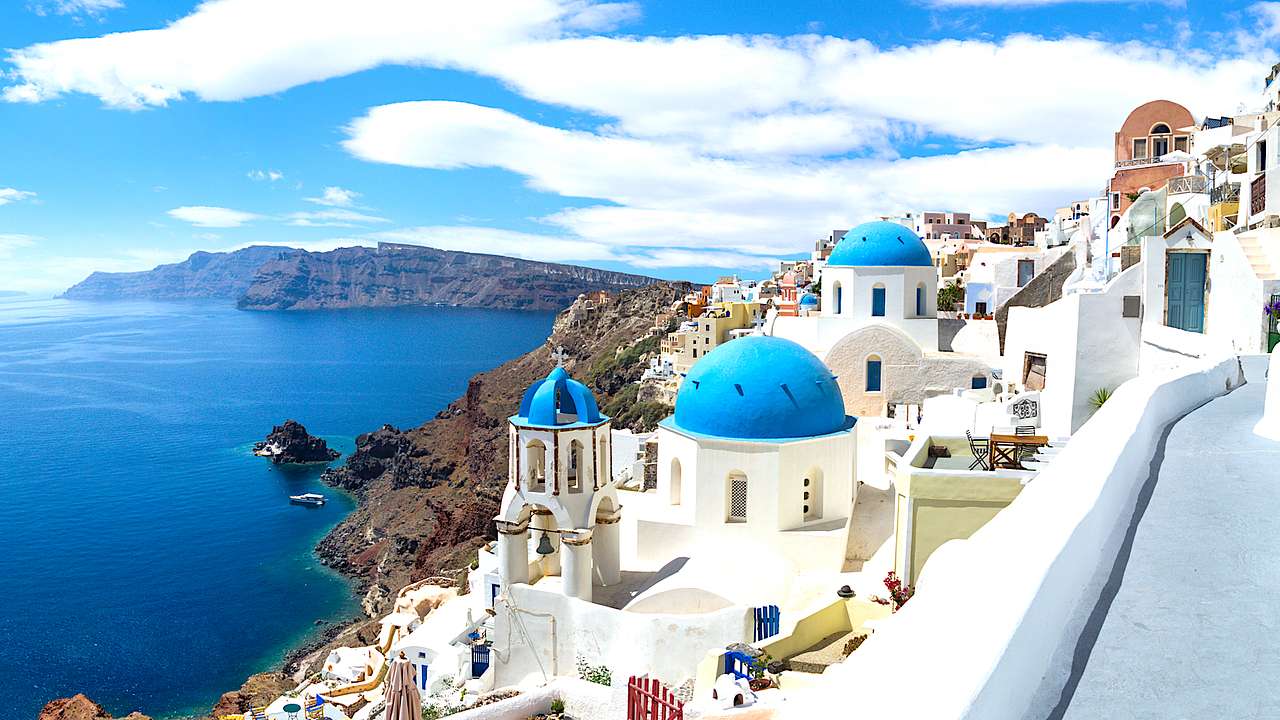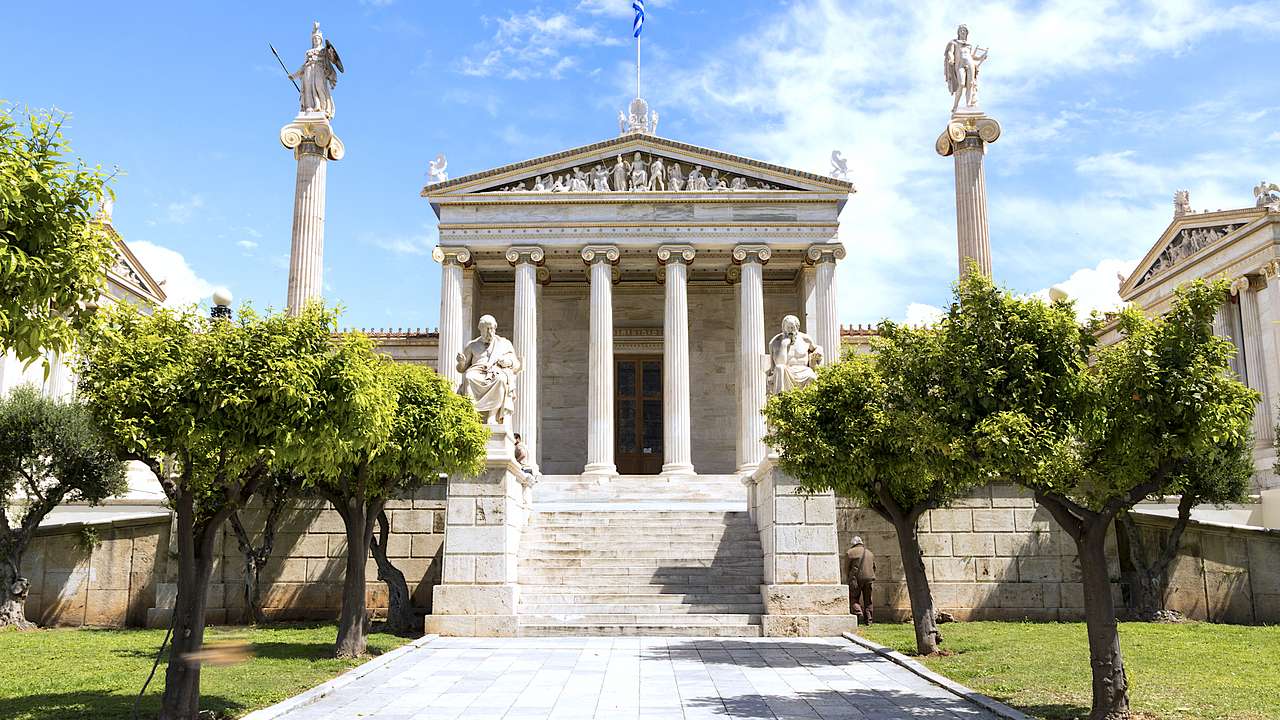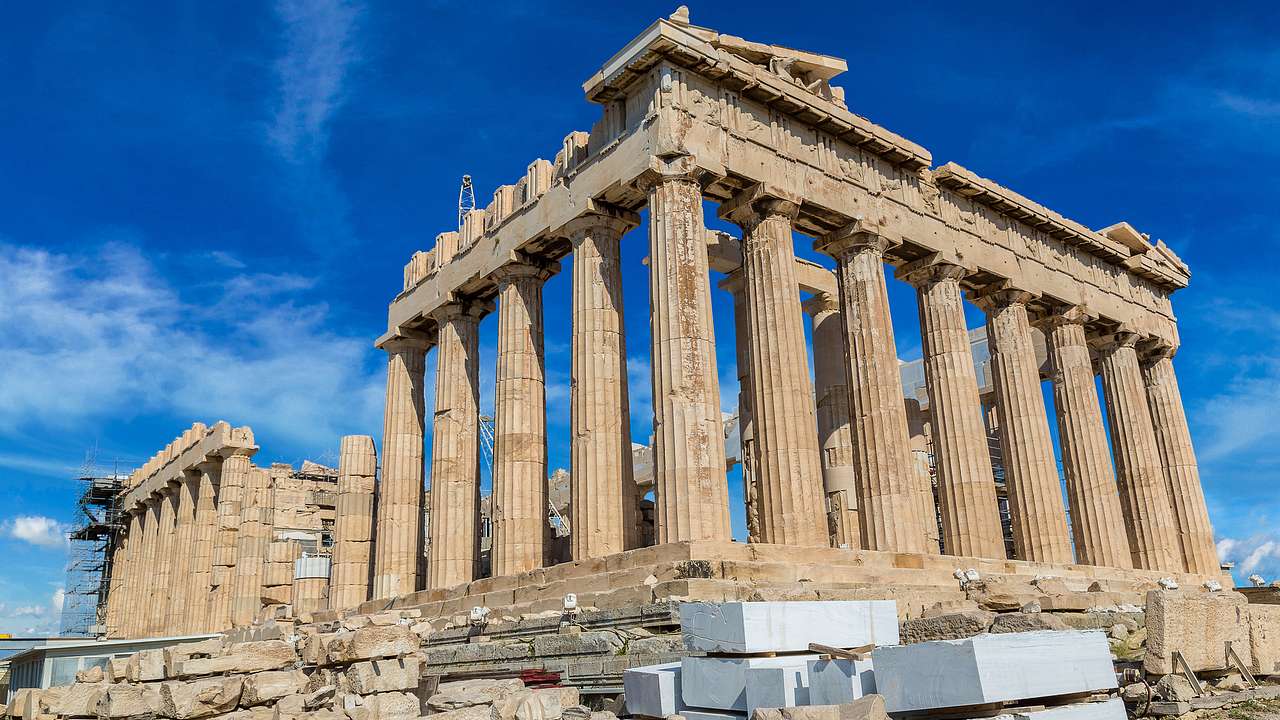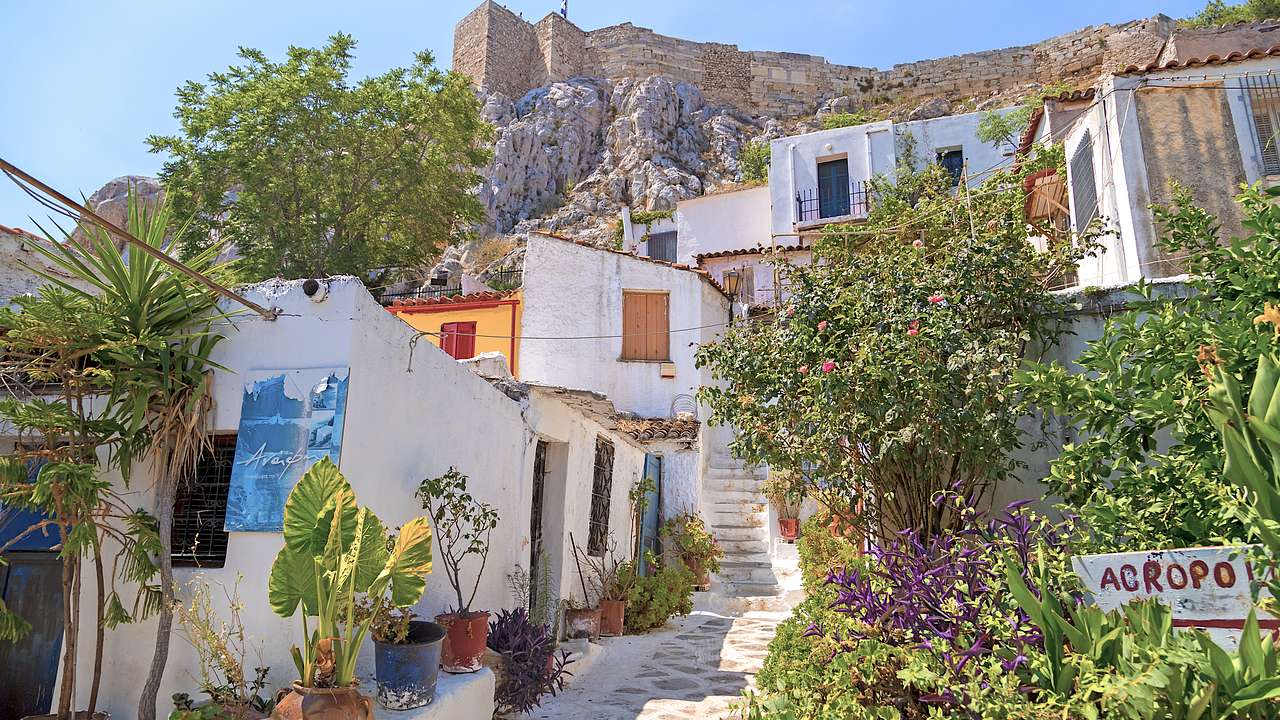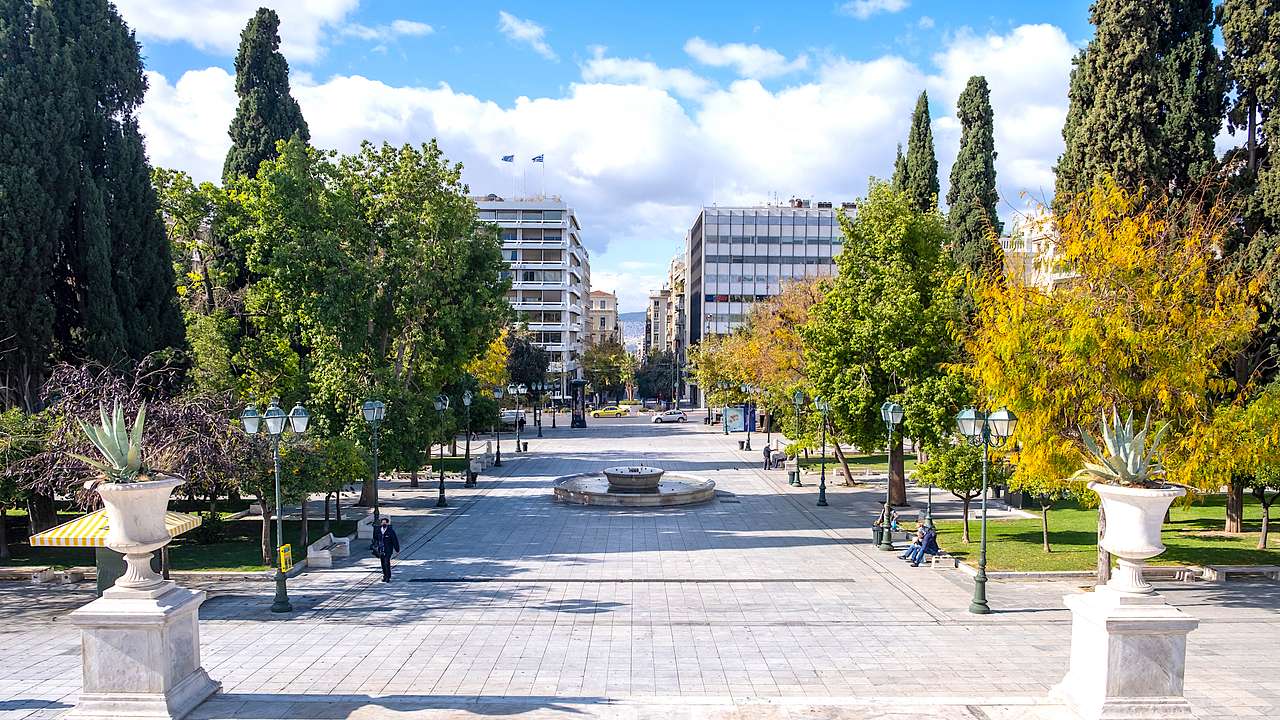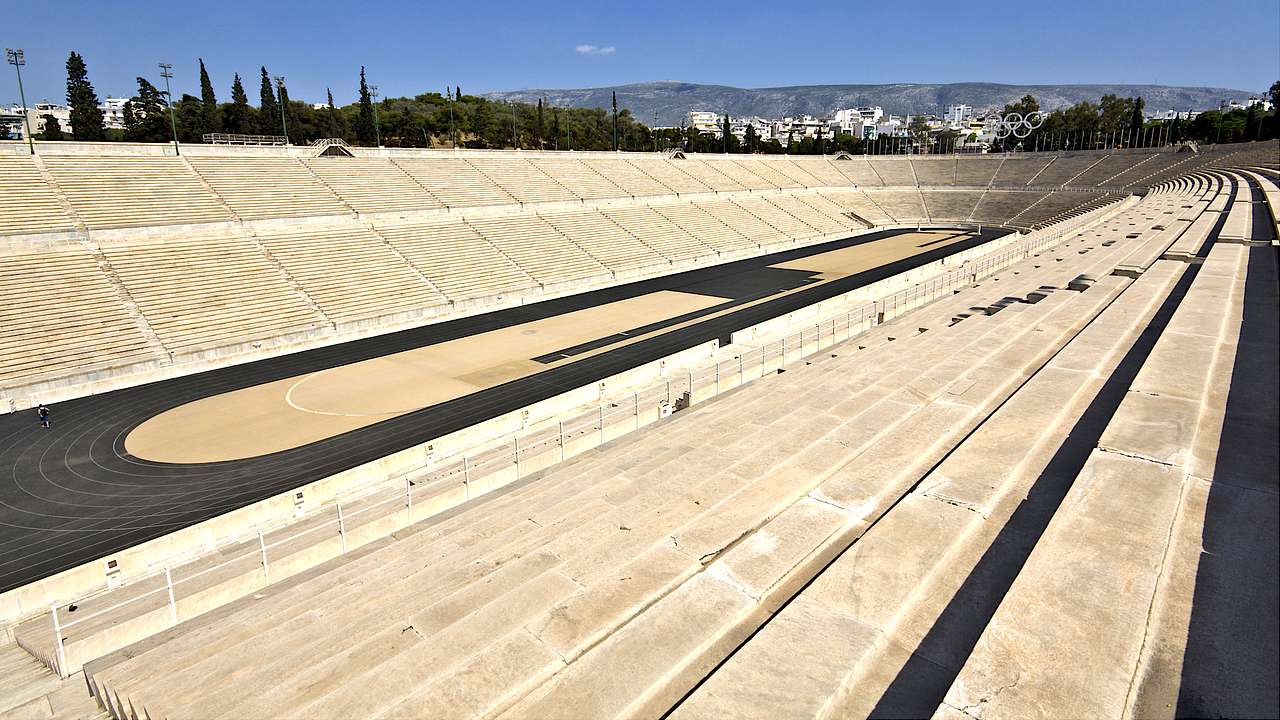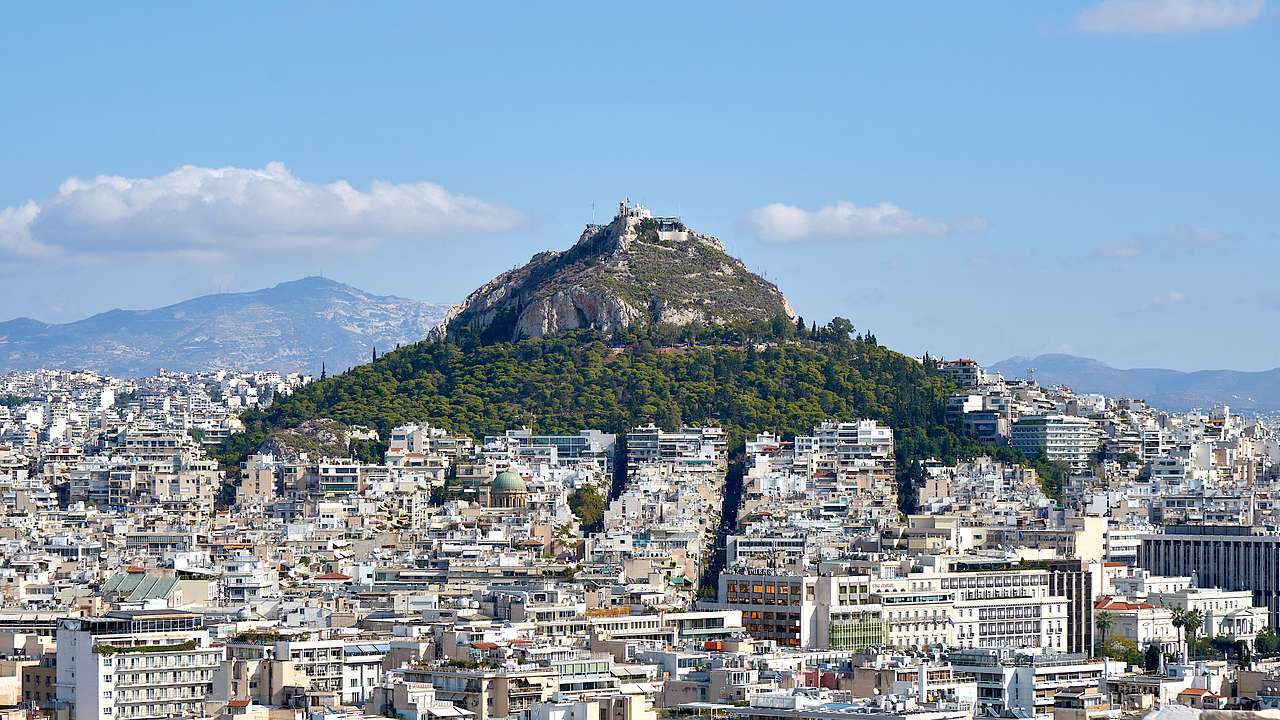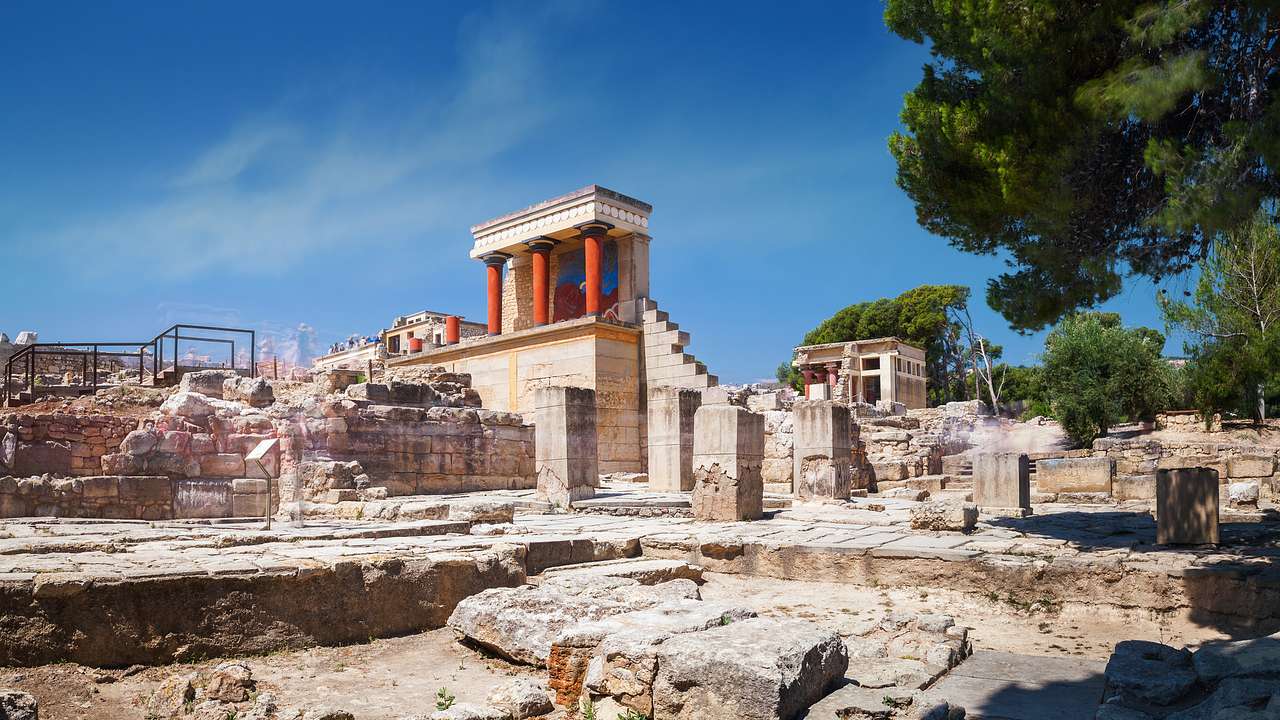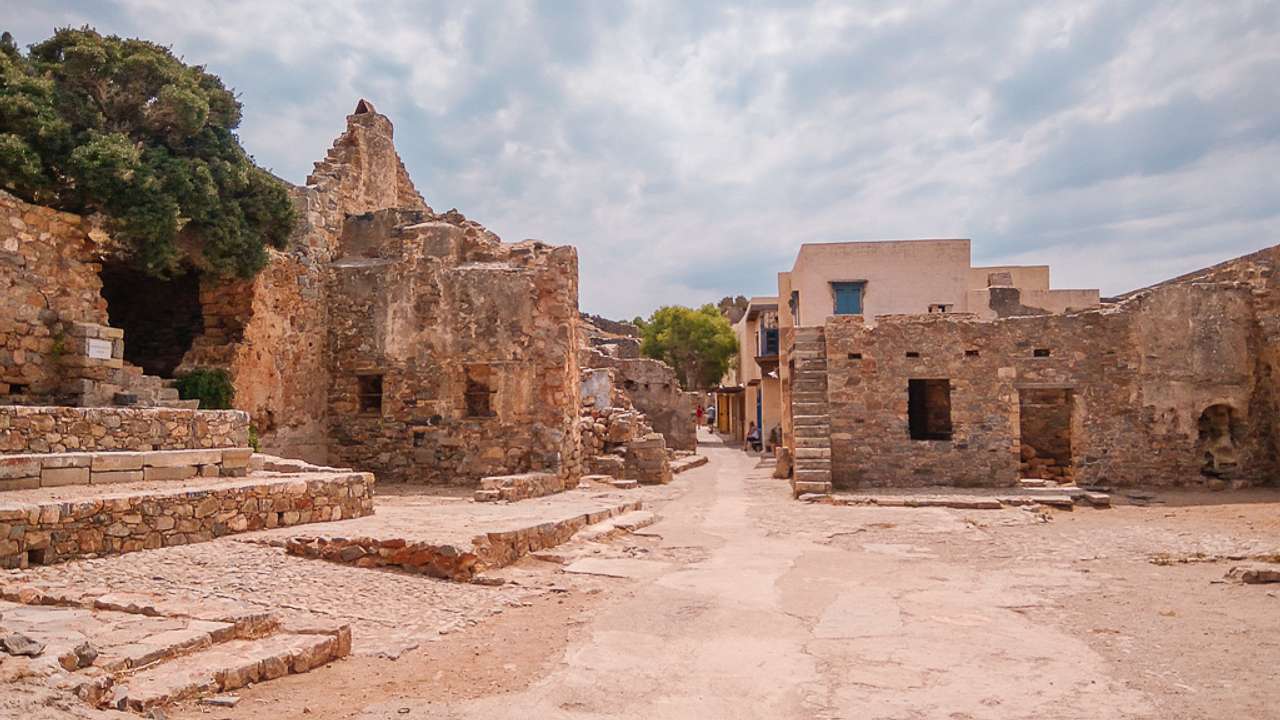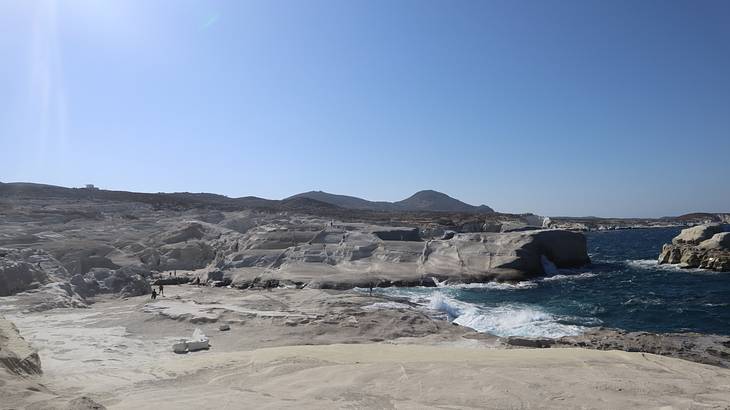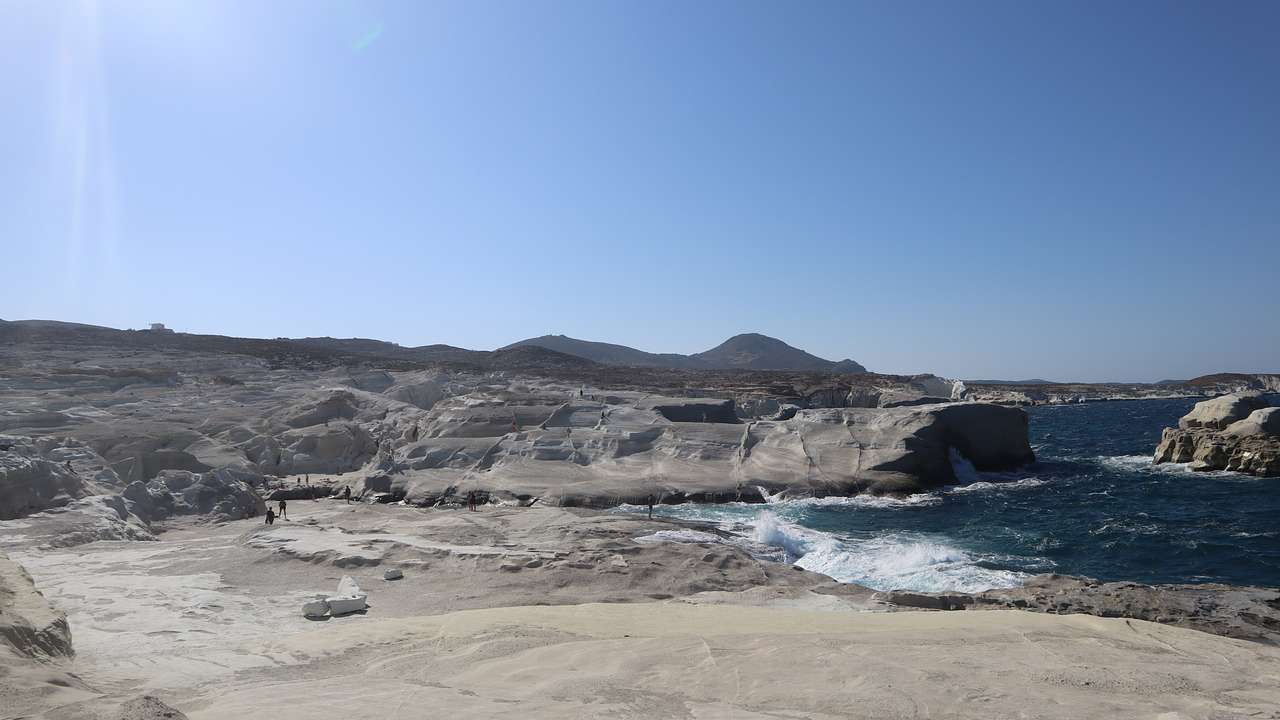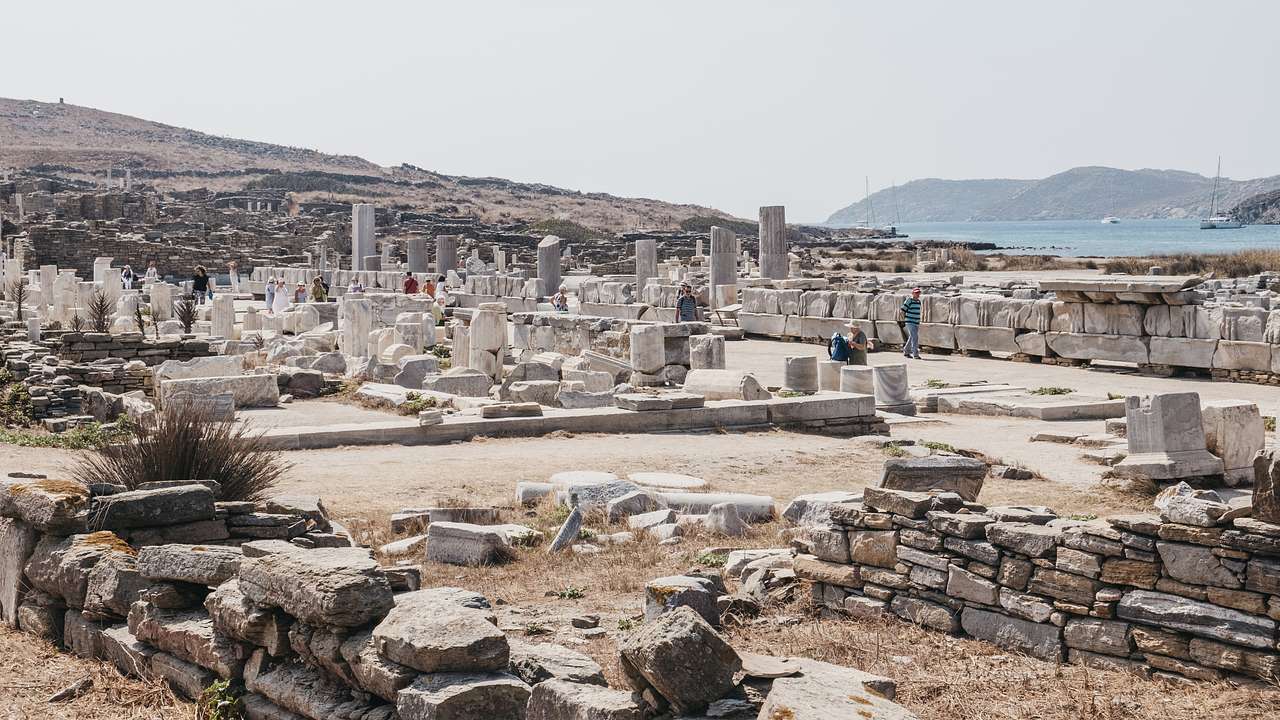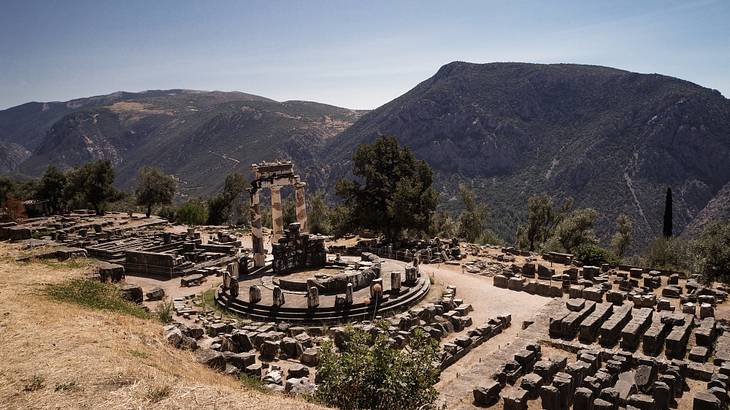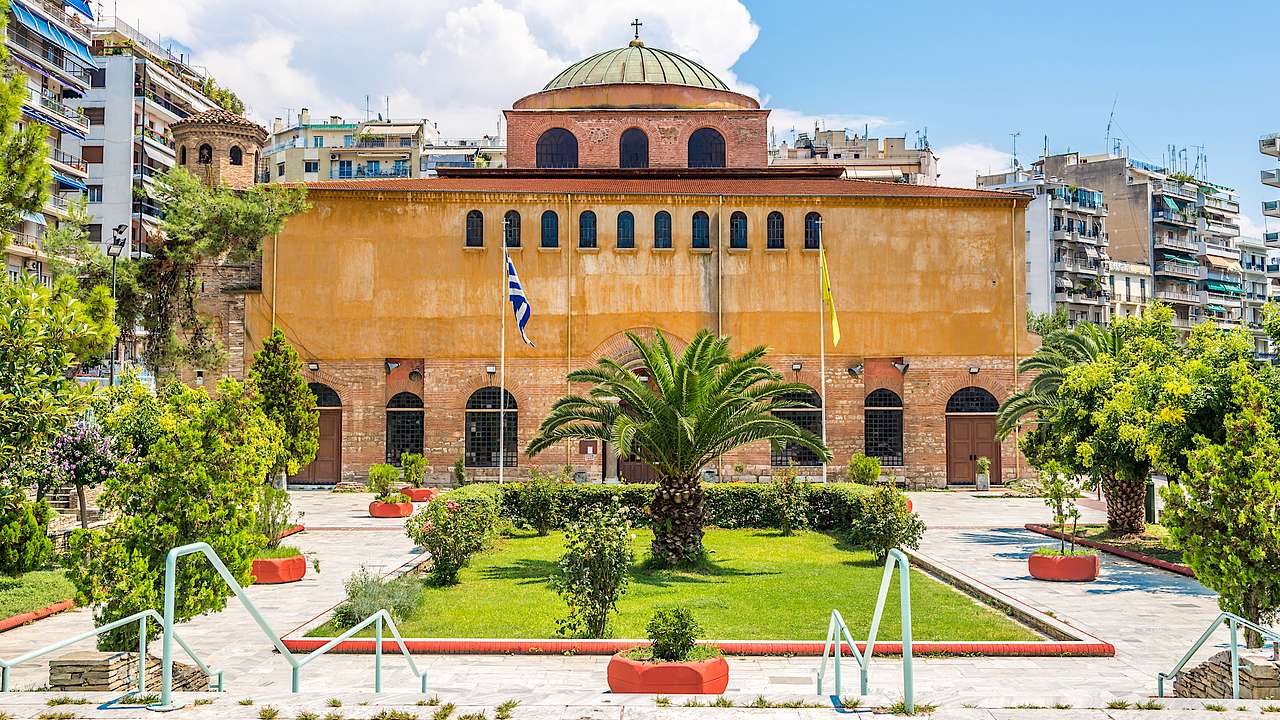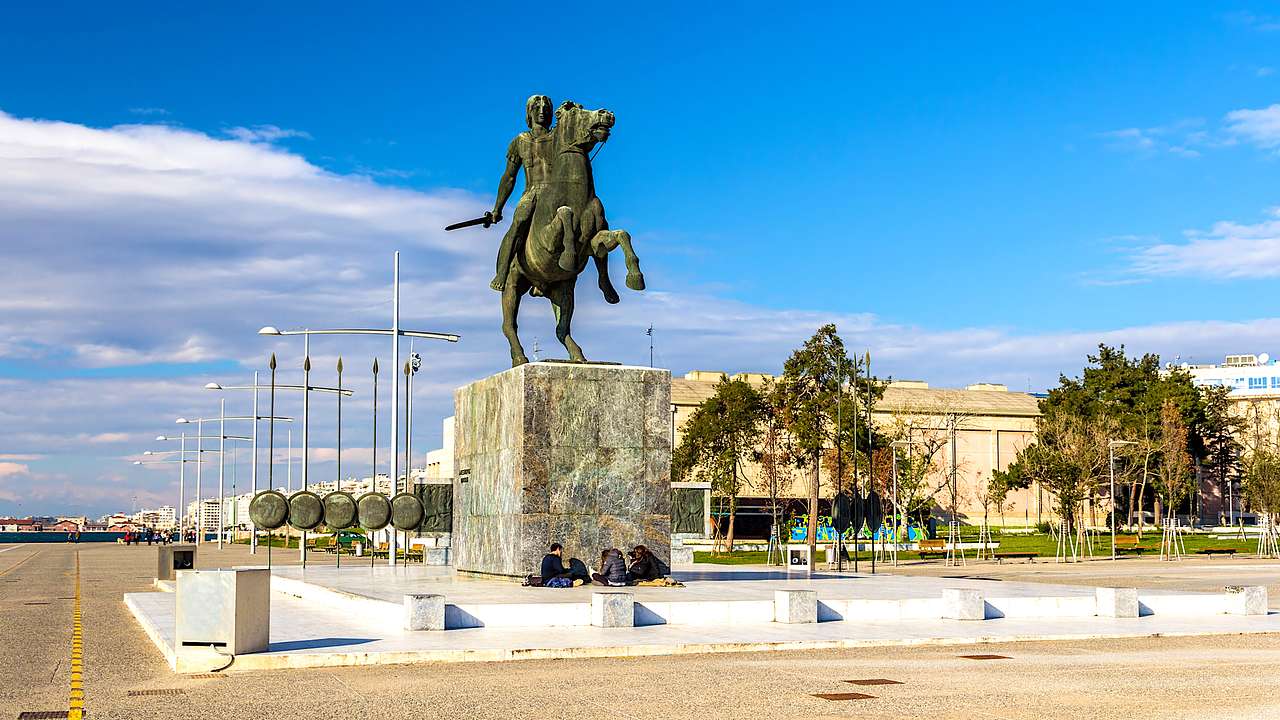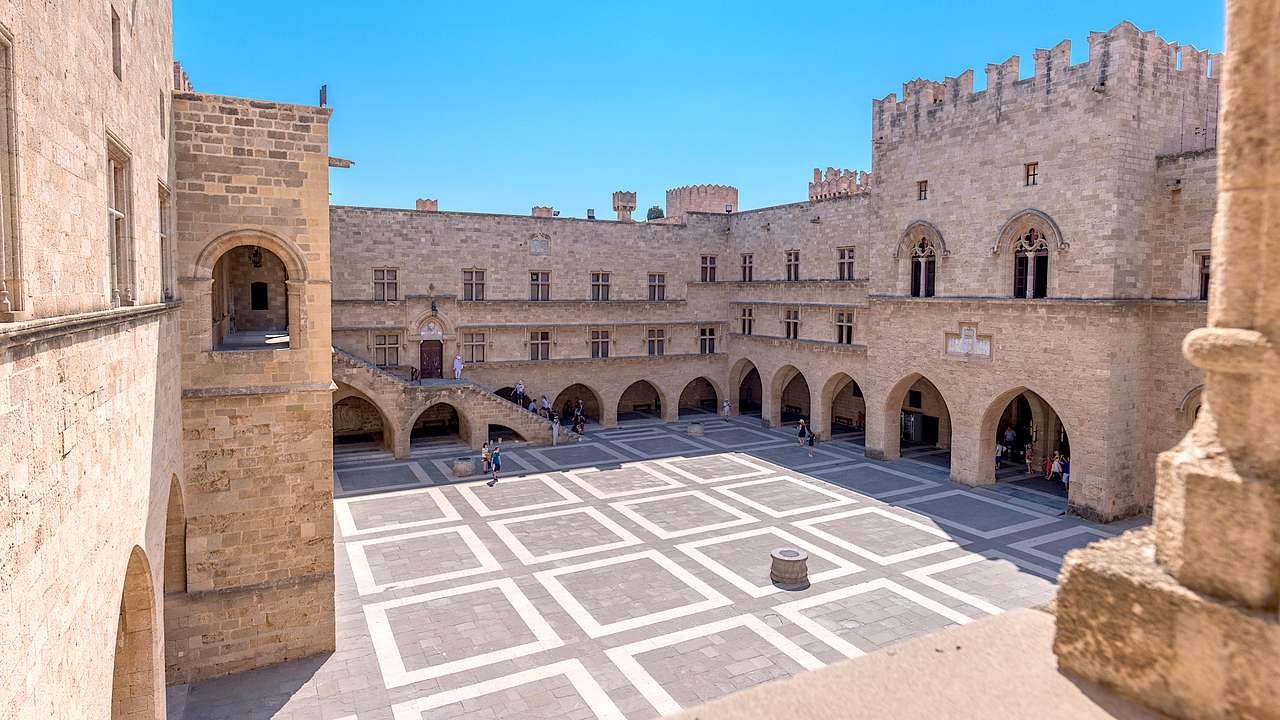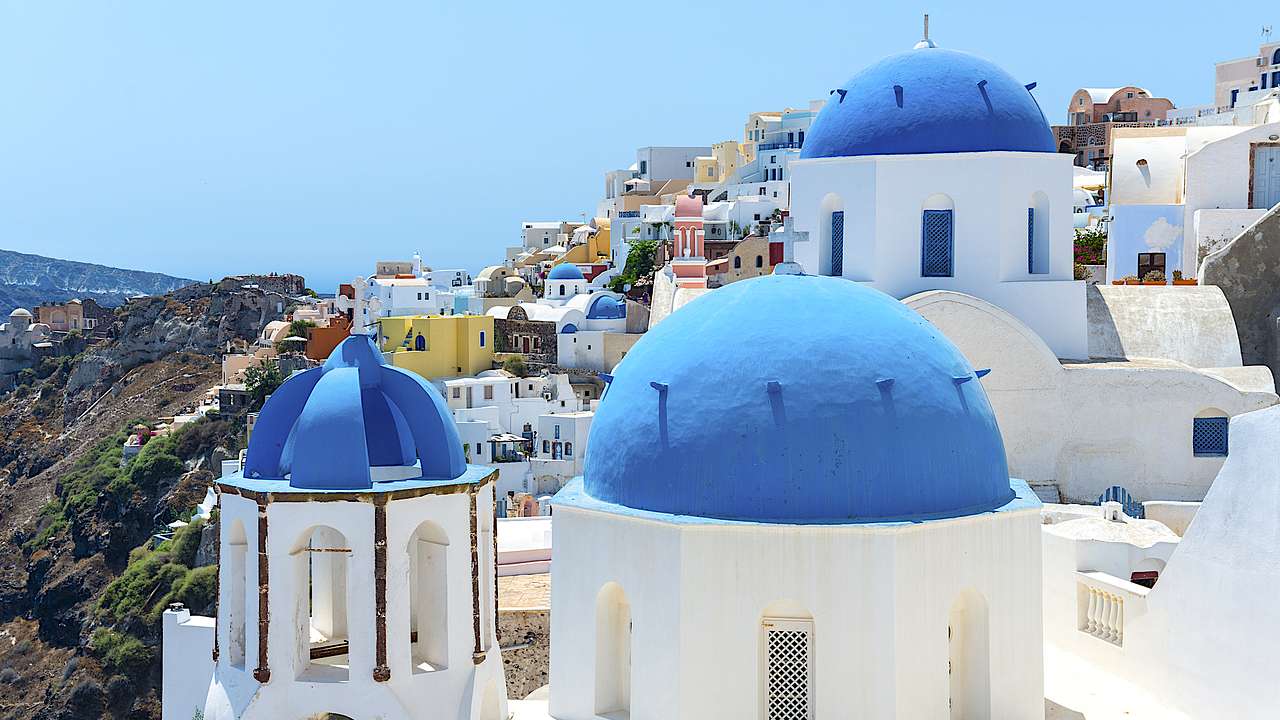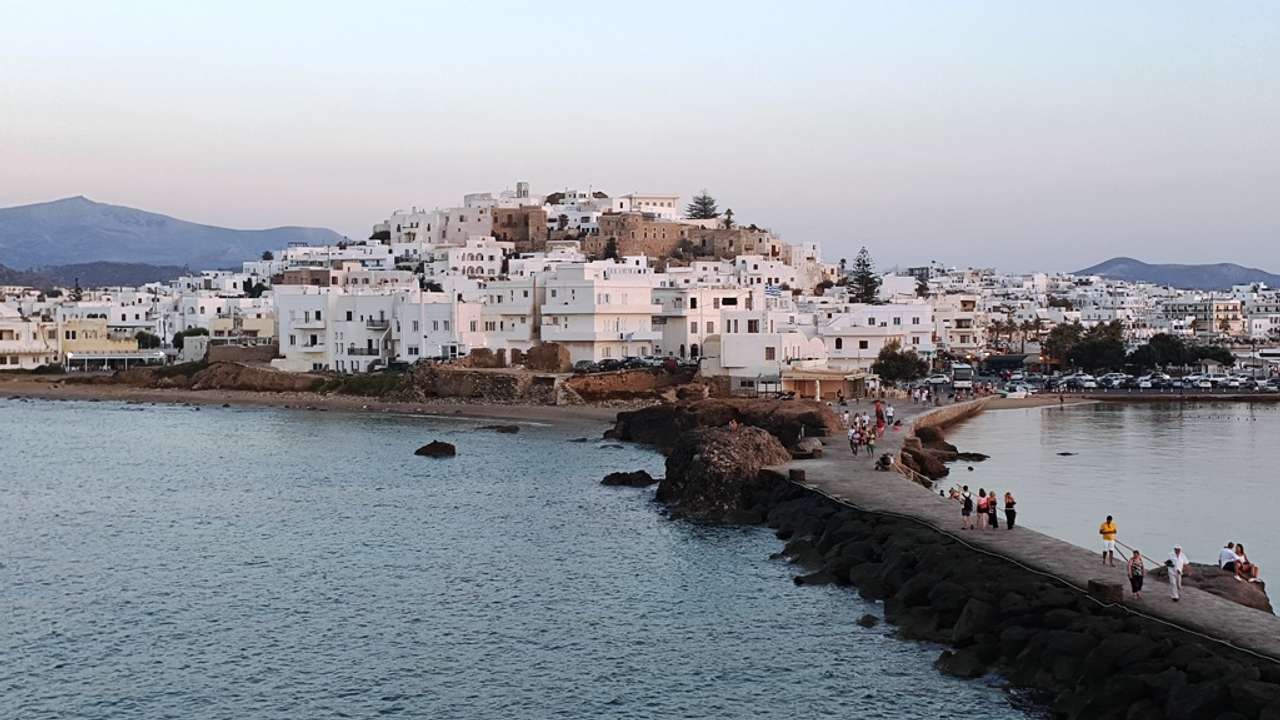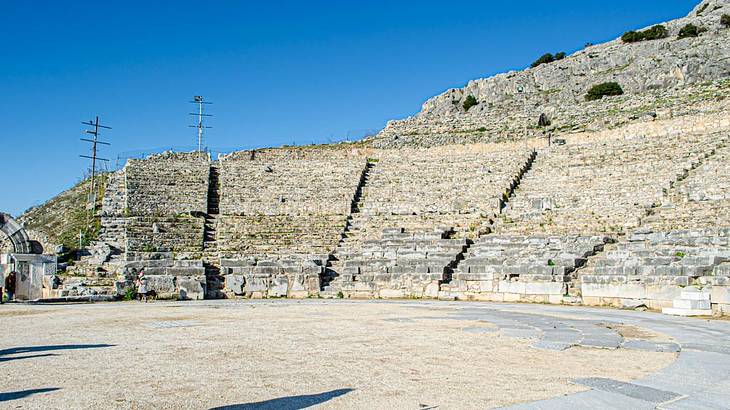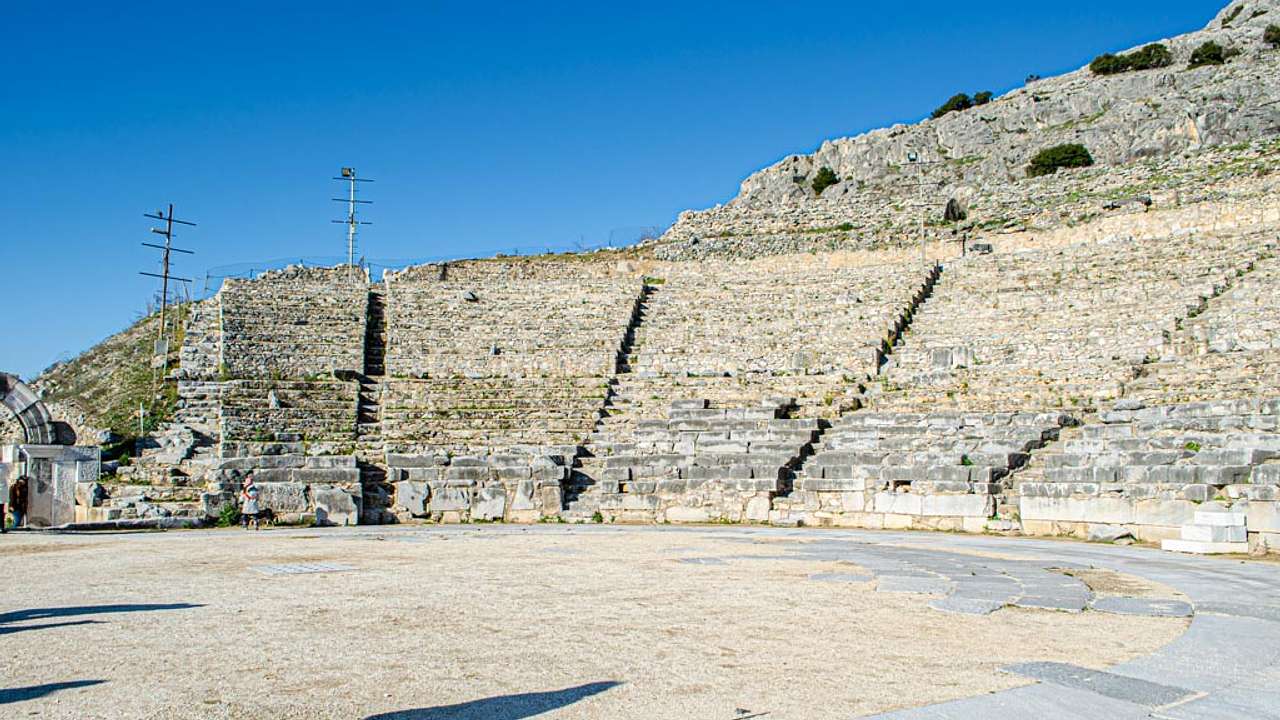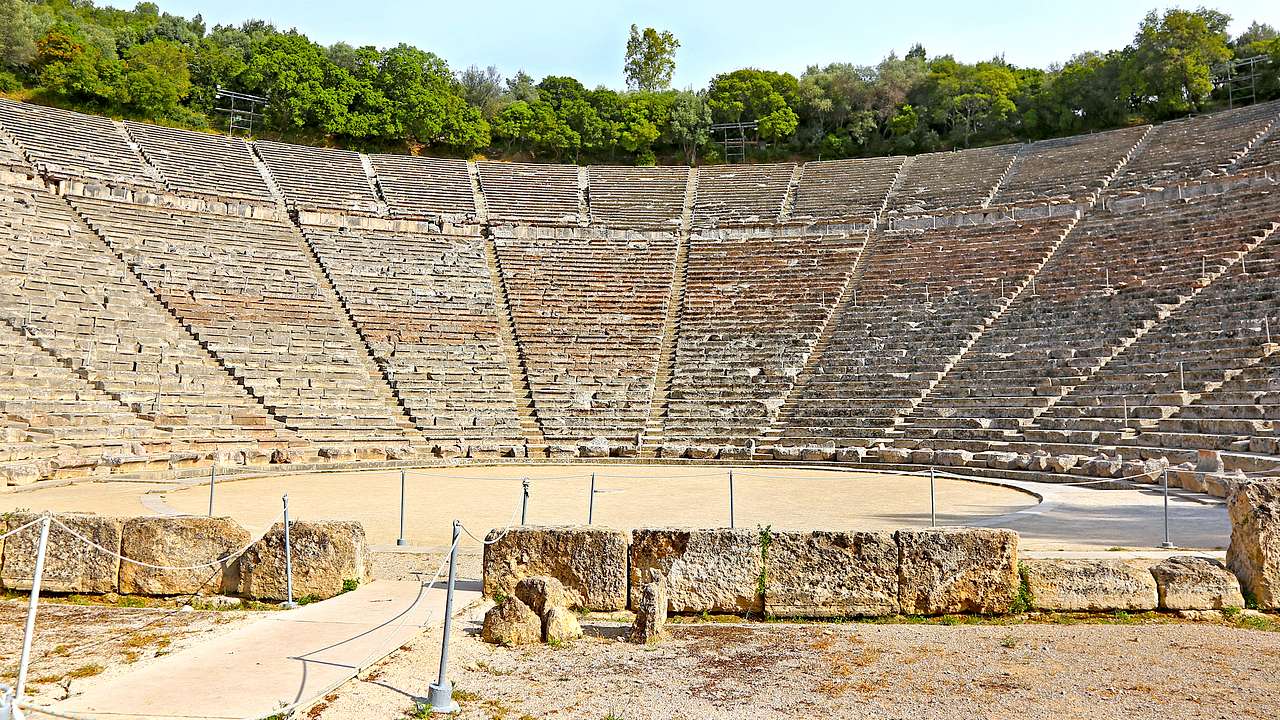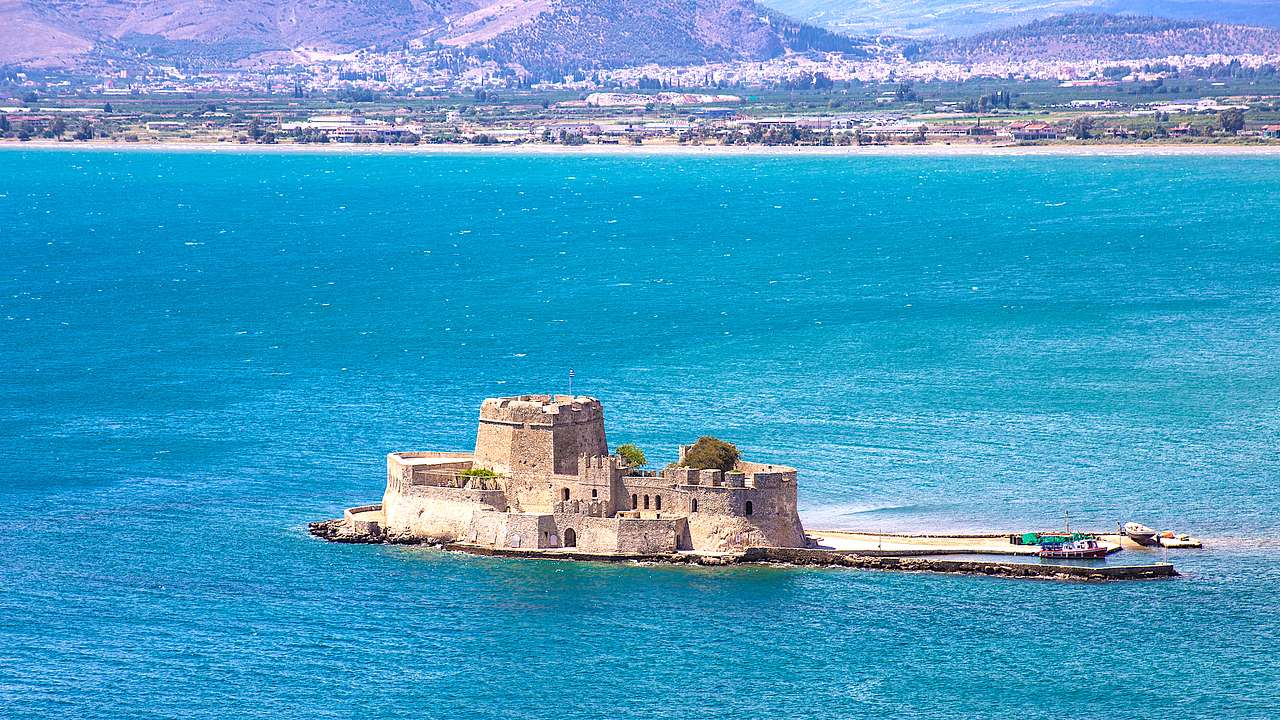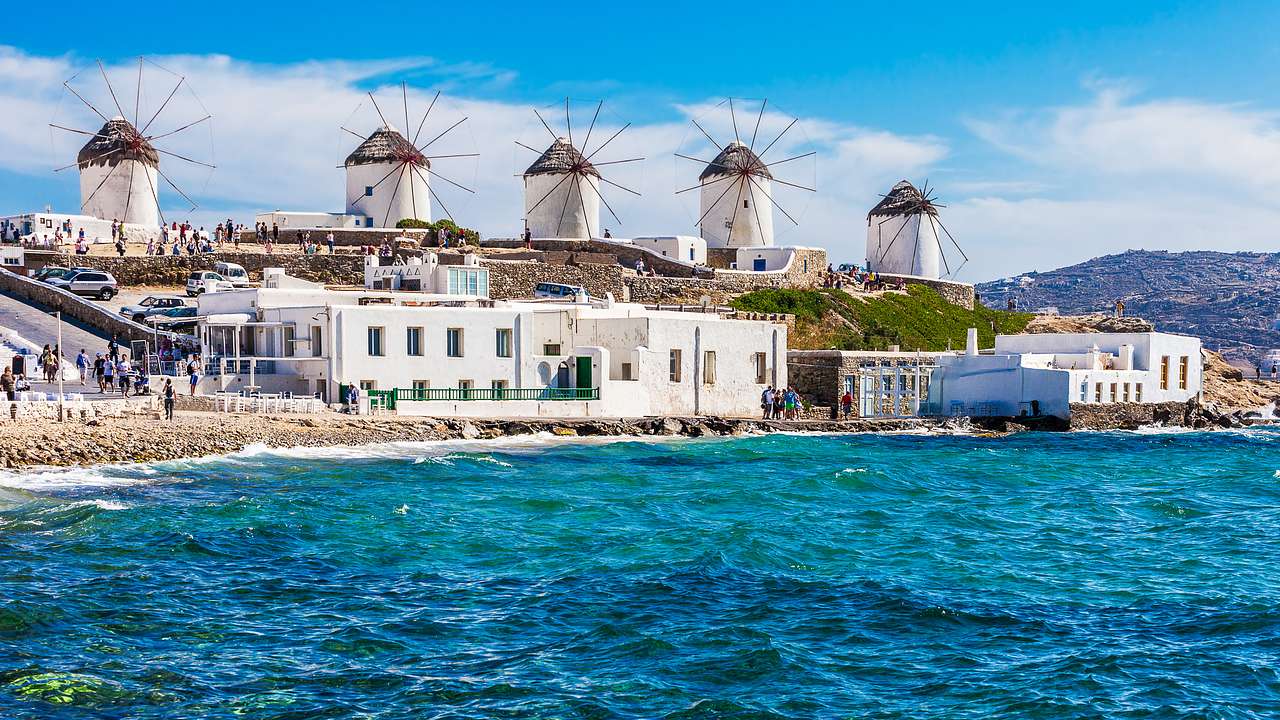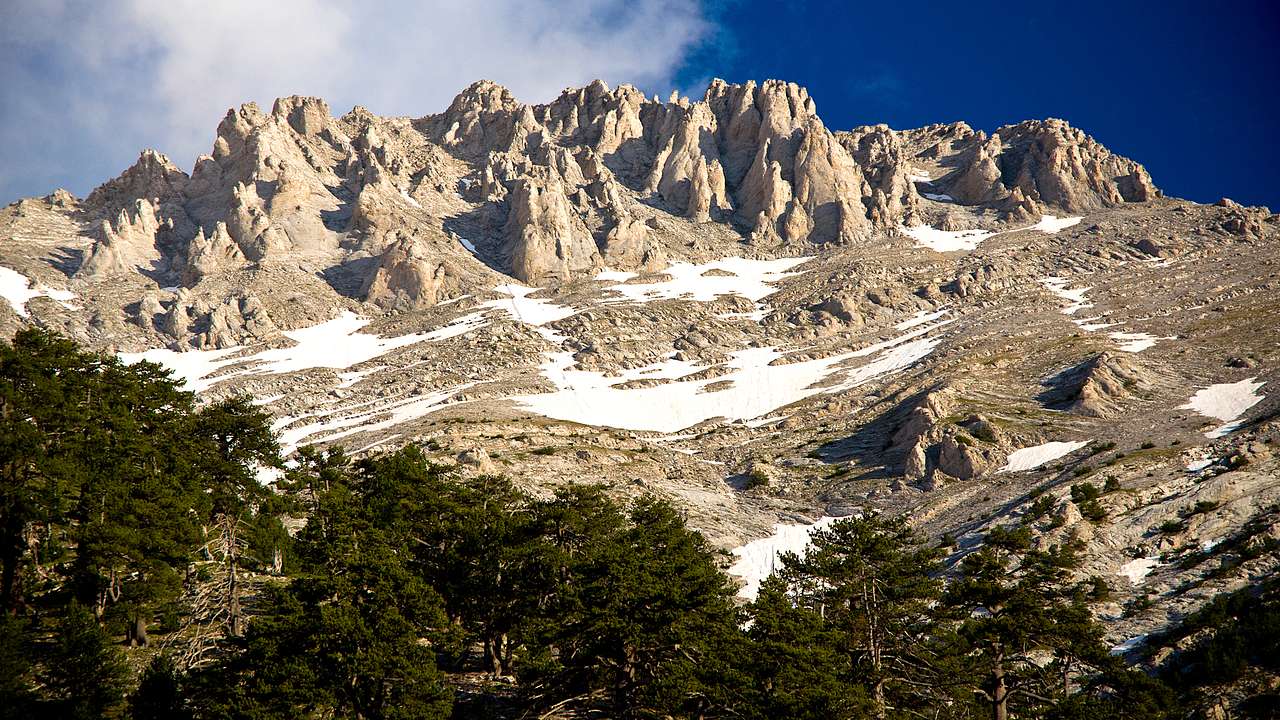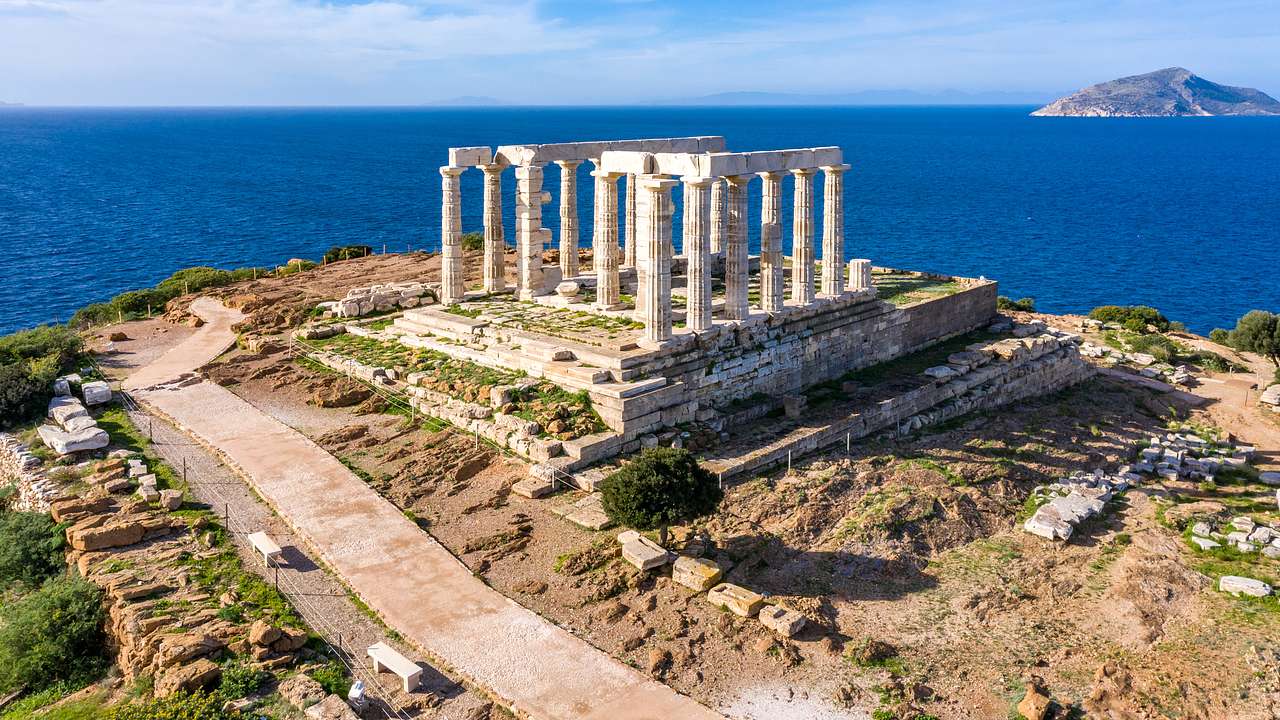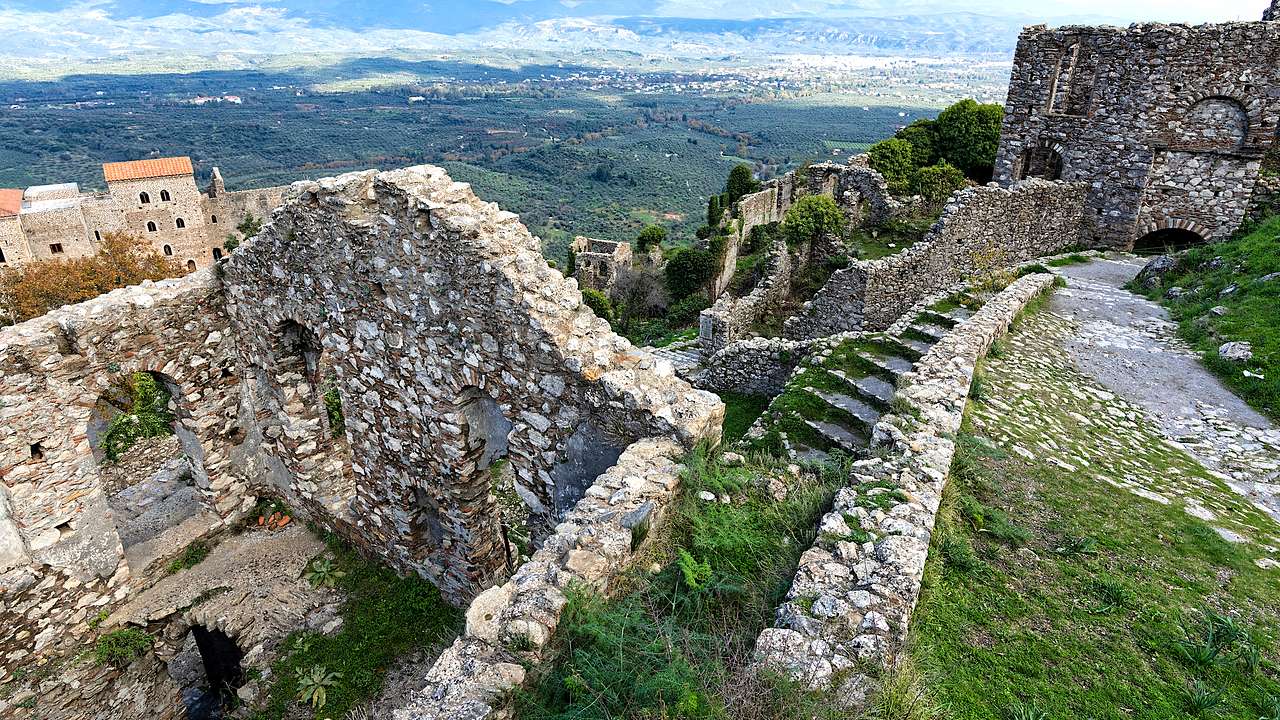35 Famous Greek Landmarks to Visit
Destguides may receive commissions from purchases made through affiliate links in this article.

Greece is a country filled with so much history and some of Europe's top landmarks. It has many ancient monuments and famous Greek landmarks that attract hoards of tourists each year.
Greece is also the perfect country to learn about ancient history while relaxing at the same time. It is actually a great place to visit for some European winter sun as it has milder temperatures.
There are lots of places to visit when you are in Greece. From enticing old temples and palaces to crumbling ruins and coastal cities, it is a must-visit country in Europe.
The capital of Greece, Athens, has many landmarks dating as far back as the 5th century B.C; for example, The Parthenon Temple.
Aside from The Parthenon, some of the top historical landmarks in Greece include the Palace of the Grand Master of the Knights of Rhodes and the Monasteries of Meteora.
If ancient ruins aren't your thing, then Greece has several impressive natural landmarks as well. These include Zakynthos and Corfu, the Ionian Islands.
This Greece travel guide captures some of the most famous landmarks in Greece so that you are left feeling inspired for your upcoming Greece vacation and have a memorable trip! Some helpful tips from other travel bloggers are included as well.
Organizing a last-minute visit to Greece?
Book your entrance tickets and tours for your trip to Greece early! Here are some top choices to make your trip enjoyable.
☂️ Top tours and experiences in Greece
- Skopelos - The Mamma Mia Island Tour (likely to sell out)
- Acropolis Monuments & Parthenon Walking Tour With Optional Acropolis Museum (likely to sell out)
- From Athens - Hydra, Poros, & Aegina Day Cruise With Lunch (likely to sell out)
- Acropolis & Parthenon Guided Walking Tour
- Athens - Cape Sounion & Temple of Poseidon Sunset Tour
35 Famous Landmarks in Greece
- Acropolis Museum, Athens
- Academy of Athens, Athens
- Temple of Olympian Zeus, Athens
- The Acropolis, Athens
- Ancient Agora of Athens, Athens
- Parthenon, Athens
- Plaka, Athens
- Syntagma Square, Athens
- Panathenaic Stadium, Athens
- Mount Lycabettus, Athens
- The Palace of Knossos, Crete
- Chania Old Town, Crete
- Spinalonga Island, Crete
- Sarakiniko Beach, Milos, Cyclades Archipelago
- Delos, Cyclades Archipelago
- Ancient Corinth, Corinth
- Corinth Canal
- Sanctuary of Delphi, Delphi
- Cathedral Church of Hagia Sophia of Thessalonica, Thessaloniki
- Monument of Alexander The Great, Thessaloniki
- Palace of the Grand Master of the Knights, Rhodes
- Lindos Acropolis, Rhodes
- Domes of Santorini, Santorini
- Akrotiri, Santorini
- Apollo Temple - Portara, Naxos
- Archeological Site of Philippi, Krinides
- Ancient Theatre of the Asklepieion at Epidaurus, Epidavros
- Bourtzi Castle, Nafplio
- Ionian Islands
- Mykonos Windmills, Mykonos
- Mount Olympus, Olympus Range
- Archaeological Site of Olympia, Olympia
- Monasteries of Meteora, Kalabaka
- Temple of Poseidon, Cape Sounion
- Archaeological Site of Mystras, Laconia
Greece Landmarks Video
Check out our highlights video of Greece landmarks.
Greece Landmarks Map
A map of Greece landmarks. Use the map to explore all of the points of interest.
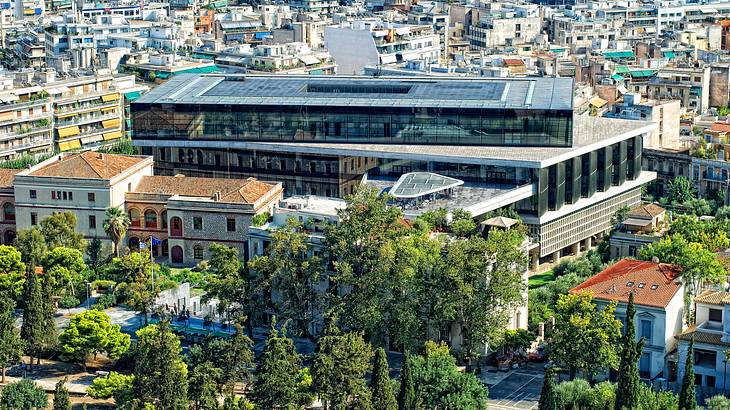
Acropolis Museum, Athens
The Acropolis Museum is undoubtedly one of the most famous landmarks in Athens, Greece. It is an archaeological museum that opened in 2009, and it is located in the centre of the city.
The museum that stands today was built to replace the first museum erected in 1874 on the Hill of the Acropolis. The reason being that more artefacts were discovered after more excavations took place at the Acropolis. The old museum could not hold the new-found artefacts for exhibitions, so a new one had to be built.
The museum has many intriguing parts for visitors to explore. One is the Gallery of the Slopes, a transparent floor that reveals the results of the excavations below. It also showcases artefacts that were found during the excavations.
Another interesting piece at the museum is the Parthenon Procession (The Frieze). It is on display on the third floor and contains pieces from the Parthenon, also located at the Acropolis.
☂️ Explore the Acropolis Museum on a tour
- Acropolis Monuments & Parthenon Walking Tour With Optional Acropolis Museum (frequently sold out)
- Athens Full Day Private Tour (widely sought after)
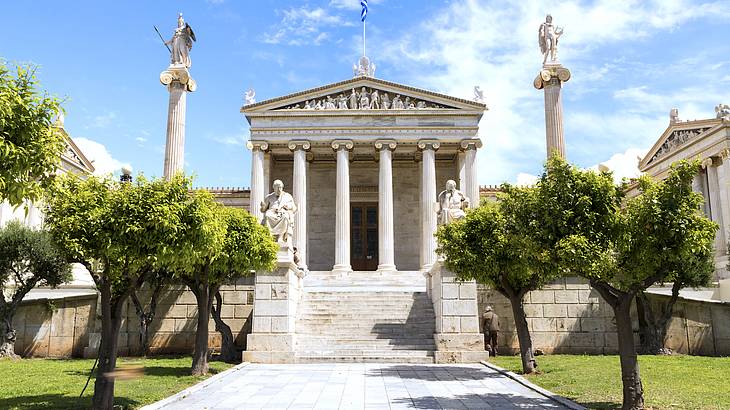
Academy of Athens, Athens
The Academy of Athens is another thrilling Greek landmark in Athens to keep an eye out for. Even though it was built in a modern form, it still exhibits the achievements of ancient Greece beautifully. It is a national academy and the highest research institution in Greece presently.
The Academy was constructed in 1926. Today, its activities are supervised by the country's Ministry of Education. One of the major landmarks of Athens is the main building of the Academy; it has an antiquated architectural design with modern execution.
☂️ Explore Academy of Athens with a tour
- Athens Half-Day Sightseeing Tour (very popular)
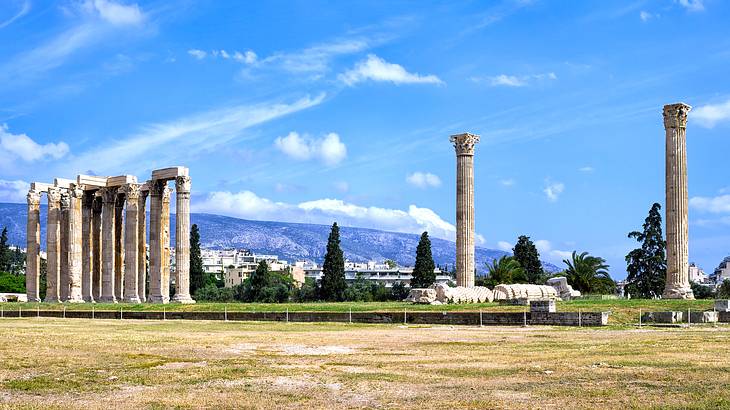
Temple of Olympian Zeus, Athens
The Temple of Olympian Zeus, commonly known as the Olympieion, was once the largest in the world. It is located in the centre of Athens, built to honour the Greek god Zeus who is seen as the head of the Olympian gods.
Construction of the temple took almost 650 years, beginning from the 6th century BC and completed in the 2nd century AD. The temple comprises 104 columns of marble standing over 56 feet tall, but today only 15 can be counted.
The reason for this is an earthquake that occurred during the middle ages, which destroyed most parts of the temple. Despite this, the 15 remaining columns are one of the most important remains ancient Greece offers.
Visiting the temple shows you how big the temple was in the ancient world and why it is essential to preserve it even today.
☂️ Visit the Temple of Olympian Zeus with an experience
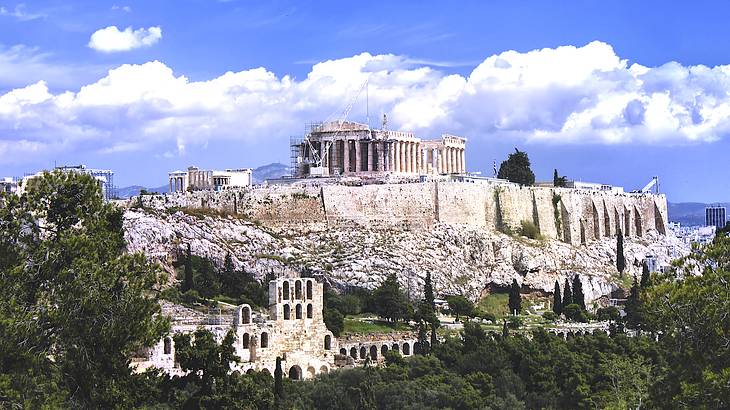
The Acropolis, Athens
The ancient citadel known as The Acropolis is an impressive landmark located in the middle of Athens, Greece. The archaeological site is at the top of a hill and within it contains arguably one of the most famous landmarks of the world and definitely in Greece, the Parthenon.
The Acropolis itself is 7.4 acres, and the earliest reference to it is from the 6th millennium BC. This landmark is massive, and its history is very rich! The Acropolis has a lot for visitors to explore. There are many ancient buildings housed within it, around 20 different sites.
If you are visiting this landmark, consider spending at least half a day exploring the area. After you enter, you'll be able to pick up a guide and start exploring the old relics and buildings that are all over this site.
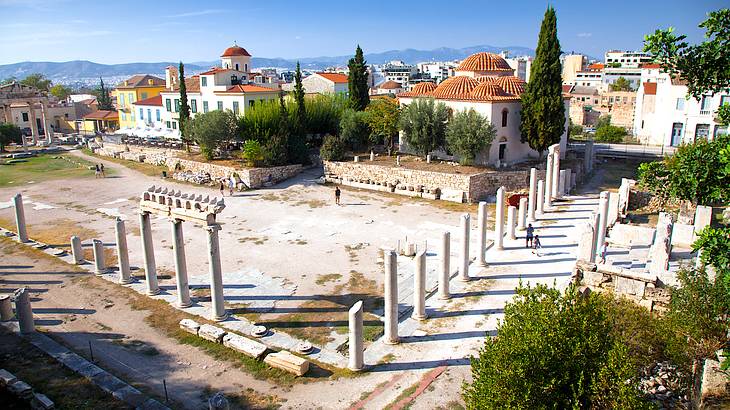
Ancient Agora of Athens, Athens
Out of all the famous landmarks and monuments in Athens, the Ancient Agora of Athens is one of the best places to start your tour of the city.
The historic landmark is located on the northwest side of the Acropolis on Market Hill. It was used as a place for gatherings, especially for political reasons.
Today, the landmark serves as a reminder of the Western Civilization of Greece. It is also a museum that exhibits artefacts from the excavations in Ancient Agora.
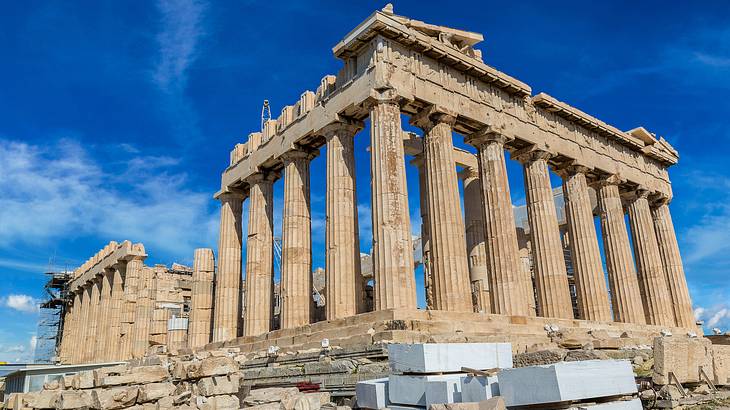
Parthenon, Athens
The Parthenon is a Greece landmark built and dedicated to Athena, a Greek god and the patron of the city of Acropolis. It is a must on any Athens itinerary!
This structure is one of the finest landmarks in Greece when considering its conception and execution. The former temple was created between 447 and 438 BC to replace the first Parthenon.
The temple's interior demonstrates the beauty of combining old and new elements to produce one of the country's most incredible ancient Greek monuments and buildings.
It is advisable to read about the temple before you visit. This will help you understand why the Greeks cherish the building to the extent they do today.
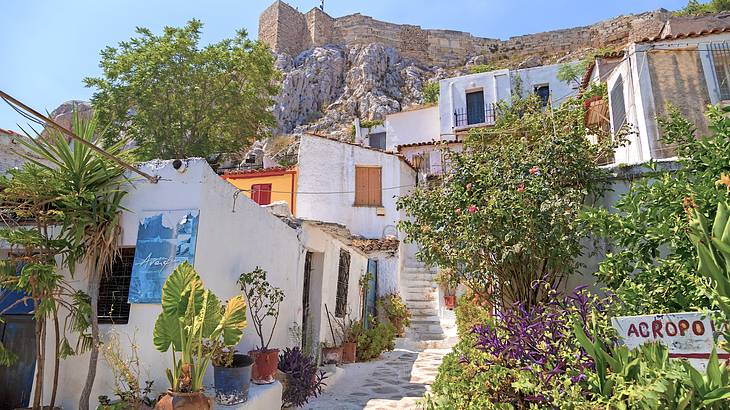
Plaka, Athens
The neighbourhood of Plaka is one of the most ancient settlements you can find in Europe. For Greece, it is the oldest settlement in the country, having more than 3,500 years of history to share with visitors. Plaka is located near the Acropolis and is well known for its colourful flowery streets.
Within Plaka, you can visit the Museum of Greek Folk Musical Instruments. Another impressive landmark in Plaka is the Roman Agora, the first-ever commercial centre of Athens built to honour Julius Caesar.

Syntagma Square, Athens
Syntagma Square is another of the famous monuments in Greece in Athens, again in the centre of the city. It is the second-largest square in Greece after Spianada Square on Corfu Island.
When translated into English, Syntagma Square reads as the Constitution Square. The Square is surrounded by many ancient monuments that describe the history of Greece.
Syntagma Square is the best place to start your walk around Athens. You can also use this opportunity to visit the Parliament House for a tour.
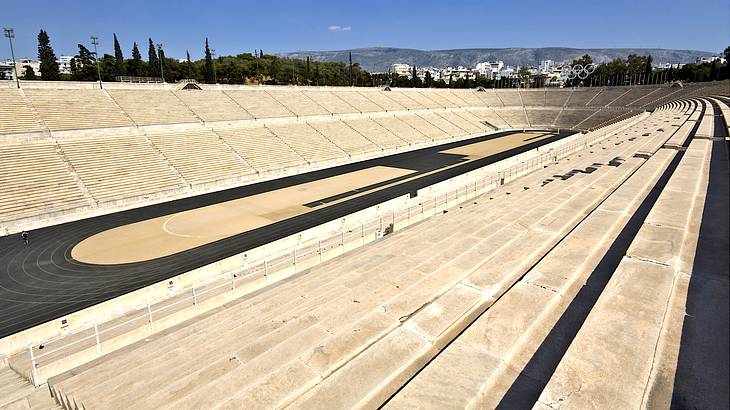
Panathenaic Stadium, Athens
The Panathenaic Stadium, or Kallimarmaro for short, is a multi-purpose stadium built in the fourth century BC in Athens. It was mainly created for the Panathenaic Games, which was held every four years.
The entire stadium was made with only marble, and it is the only stadium in the world of its kind. It was easily one of the most famous places in ancient Greece. The stadium was reconstructed in 1896 for the Olympic games.
During its first Olympic appearance, the stadium was used to host the opening and closing ceremonies. It also hosted four out of the nine contested sports at that time.
If you are a sports person, visiting this stadium will show you how far sports, especially the Olympics, have come.
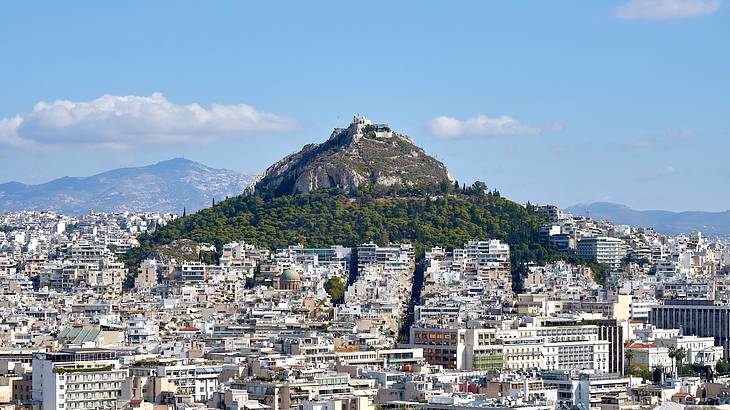
Mount Lycabettus, Athens
Mount Lycabettus is the highest point in the capital city of Greece and is made of limestone. At the top, you will find a viewing terrace, a church and a couple of bars and restaurants offering unobstructed, 360-degree views of the surrounding area, including the Olympic Stadium and the Acropolis.
To get to the viewing platform at the top of the hill, head to the funicular and climb a few sets of stairs, and then you'll reach it. If you feel adventurous and can do so, you can climb to the mountain peak starting from Syntagma Square. Whichever method you choose, you will be presented with breathtaking views of the area.
☂️ Experience Mount Lycabettus with a tour
- Four Hours - Athens & Acropolis Highlights Private Tour (widely acclaimed)
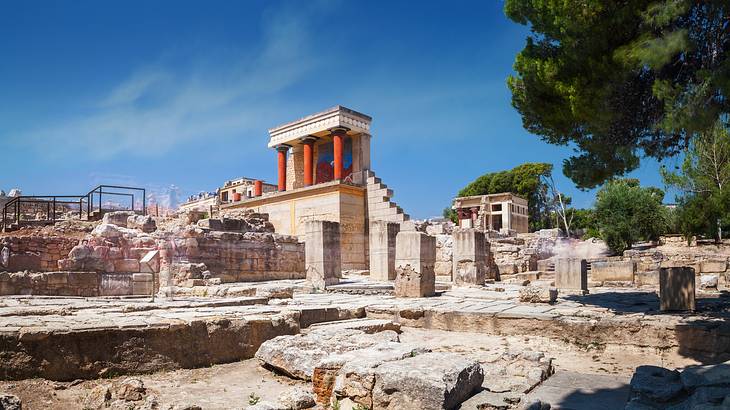
The Palace of Knossos, Crete
Knossos Palace was once used as the political and ceremonial centre during the Minion Civilization in the Bronze Age. Knossos proper is considered one of the oldest cities in Europe, and it used to be a city in ancient Crete.
The Palace was affected by a terrible earthquake, but it was reconstructed shortly after. For unknown reasons, the Palace had to be abandoned around 1380 until 1100 BC.
Some of the locals believe that the Palace of Knossos is the same as the Palace in Greek mythology relating to the Minotaur tale. The Minotaur in Greek mythology was a half man half bull creature who was kept in the Labyrinth, a maze by King Minos, the ruler of Crete.
☂️ Join a tour to see Knossos Palace

Chania Old Town, Crete
Being the second-largest city in Crete, Chania is one of the most beautiful Greek cities that certainly deserves attention. It's also one of the best places to stay while in Crete!
The city has been ruled by various empires over the centuries and is steeped in history. This is evident in the remaining architecture, food, and culture. Chania was rebuilt during the second Byzantine period between 961 to 1204 AD. Kasteli fortress that you see today are the remains of what was built then.
Chania came under Venetian rule during the 14th century. During this period, the Venetian Harbour was constructed. The Venetians also erected mansions and churches and fortified the town.
But these didn't last long since the city was captured by the Ottomans, who ruled the region for many centuries together. This was the time when quite a few churches were turned into mosques as well.
Yali Mosque (also known as Kucuk Hasan Mosque), which sits along the harbourfront, was the first mosque built by the Ottoman Turks in 1649. After several revolts, Crete was re-united back with Greece in 1913.
Today, Chania is a buzzing seaside city and one of the busiest ports, and a port of call for many cruise ships. Chania Old Town is a fantastic place to walk around and admire the remains of the bygone era.
Explore the maze-like narrow streets. Walk along the Venetian Harbour and savour the views, or dine in at one of the seafront restaurants. A walk to the Chania Lighthouse is a must. Alternatively, you can try your hand at a Trikke tour around Chania Old Town.
Spinalonga Island, Crete
Spinalonga Island is one of the most intriguing, historically famous Greek places and a must-visit when travelling to Crete. Its history goes back to the 16th century, when the island was fortified during the Venetian rule in Crete.
Later on, it was also a refuge for the Christians and Ottomans, but today, it's mostly known as one of the last active leper colonies in Europe.
For more than 50 years in the 20th century, Spinalonga was home to this isolated community, which is the main reason why it has become such an important and highly-visited Greek landmark.
When wandering around the island, you'll see the Venetian fortress and the remains of the leper colony and get mesmerising views of the Elounda harbour. It's an open-air history museum, and visiting it is a must.
The easiest way to get to the island is by taking a day tour to Spinalonga from Heraklion (Crete's capital city) or a cruise from the town of Agios Nikolaos.
You can also take a bus to either Elounda or Plaka (the villages from where boats will take you to the island), but the timetables are not very convenient.
Sarakiniko Beach, Milos, Cyclades Archipelago
Sarakiniko Beach is easily the most famous landmark on the tiny island of Milos, one of 22 volcanic islands in the Cyclades.
Known for the unusual moon-like landscape, Sarakiniko is a unique set of coves, rocks and small beach areas, all made out of lava that's been shaped by the waves and bleached by the sun! It's unlike anywhere you've probably seen before.
To get to Sarakiniko, you can take a public bus direct from the large port town of Adamas, if you're staying there. If you're staying elsewhere on the island, such as in Pollonia or Plaka, then you'll need to take a taxi or rent an ATV.
Renting your own vehicle or ATV means you can really explore and adventure around this island, which is home to more than 70 different beaches. There's plenty of parking at Sarakiniko, but very few facilities. There are no shops, cafes or toilets, so come prepared with everything you need.
Cliff jumping is highly popular in Sarakiniko, and the contrast of the dazzling turquoise water against the white rock is amazing. You can also enter the water to easily swim from the lower areas of the lava rock, which offers small sheltered bays.
Milos is a strong contender for the most beautiful island in Greece. From its tiny fishing villages, like Mandrakia, to its charming hilltop capital Plaka and its fabulous beaches, it's a distinctly different Greek island. If you're planning a visit, you'll discover no shortage of fantastic places to stay in Milos!
Other beaches to visit include Tsigrado, which you can only access via a series of ropes and ladders through a narrow aperture, and Paliochori, which is famous for its local restaurant that cooks its dishes in the sand.
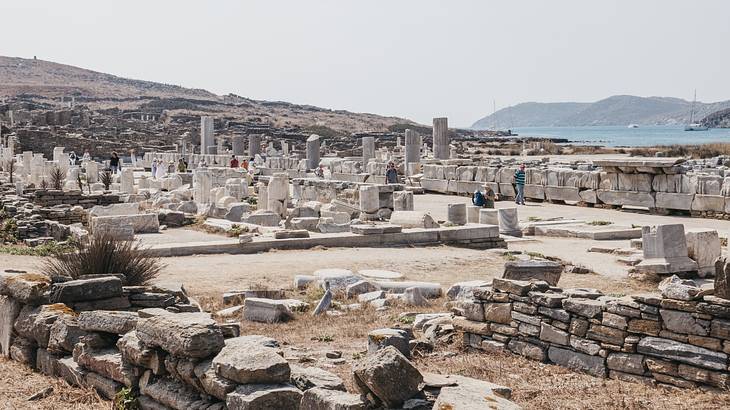
Delos, Cyclades Archipelago
Delos is a Greek island and archaeological monument located in the Aegean Sea's Cyclades archipelago. It is the mythological birthplace of Apollo, and it was a religious centre during the 1st millennium BC. The Archaeological Museum of Delos exhibits statues and remains excavated from the site.
The island has many monuments you can visit depending on your interests. If you love art, you can explore the Archaeological Museum. You can also see the Terrace of the Lion statues, houses with mosaics, and even the amphitheatre.
☂️ Visit Delos with an excursion
Ancient Corinth, Corinth
The most famous, largest and wealthiest of the ancient Greek city-states was Corinth. Today, Ancient Corinth (and the Acrocorinth above it) exists as an entire excavated city within the Ancient Corinth archaeological zone. You can wander the city-state streets that were once the home of the Apostle, St. Paul.
The most spectacular and well-known monument remaining at Corinth is the 4th-century BCE Doric Temple of Apollo. You can also visit the Agora, Stoa, Lechaion Street (where the wealthy Corinthians went shopping), and the Fountain of Peirene.
In the centre of the site is the archaeological museum. It is small but contains the findings from this large excavated zone. There are four Roman murals found inside the wealthy Romans' villas who occupied Corinth for a time.
Ancient Corinth sits at the base of the Acrocorinth, which is 300 feet above sea level. This was a commanding position to defend Corinth, and the fortress built at the summit was almost impenetrable.
This meant that the Ancient Corinthians could block the land route into the Peloponnese and contributed to making them very wealthy!
They even had their own currency, two seaports and a haulage route across the narrow isthmus between their two ports. The Corinth Canal was crucial to ancient trading routes, and it is a UNESCO World Heritage protected site.
Ancient Corinth is located on the isthmus of Corinth, and it is possible to see it on a day trip from Athens.
Corinth Canal
One of the most well-known facts about Greece is that it has numerous ancient famous Greece landmarks. But Greece has other impressive human-made structures as well, such as the Corinth Canal.
The Corinth Canal connects the Saronic Gulf of the Aegean Sea with the Corinthian Gulf of the Ionian Seas. The length of the channel is 6 km, and its depth is 8 m.
The distance between the canal walls is only 25 meters, and the height of the walls themselves is 76 meters. Ships whose dimensions do not exceed 20 meters in width can move along the channel.
You can only understand how iconic this channel is by learning how many have failed to build it, starting from Julius Caesar, Caligula, Hadrian and Nero, all of who have worked on it.
In 1893, after 11 years of work, the canal was finally opened. The first small ship went through with several scratches as it was too narrow. The channel was bombed and rebuilt a few times, too.
The Corinth Canal has seven different bridges. The two bridges at the canal's mouth are unique - they are flooded, not lifted.
Sanctuary of Delphi, Delphi
In the centre of mainland Greece sits the ancient sanctuary of Delphi, once believed to be the world's navel. First settled over 3000 years ago, Delphi was home to the god Apollo and his prophesying priestess, the Pythia.
Supplicants from all over the world travelled to Delphi in search of Apollo's wisdom and guidance. The process took a whole day, and the ritual was only performed on certain days of the year.
Visiting ancient Delphi is an almost spiritual experience. You are high on Mt Parnassus' slopes, overlooking valleys of old olive trees and the sea in the far distance. In the morning, it's quiet, and still, the mountains stretching around you with the ruins dotted around the slope like a graveyard for the ancient gods.
There's something about Delphi that draws you in – from the first glimpse of the Sanctuary of Athena when you first arrive at the site to the small treasuries that dot the hillside as you walk up the Sacred Way to the Temple of Apollo.
At the top of Delphi, you're rewarded with views of the ancient stadium's ruins, which once seated over 7,000 people, and spectacular views of the mountains.
To get the most out of Delphi, visit early in the morning before the tour busses arrive. If you stay overnight in the modern town, you can be sure to get there before most tourists. That way, you can be almost alone with the ruins while you savour the sense of peace and serenity in this sacred space.
☂️ Visit Delphi with a tour
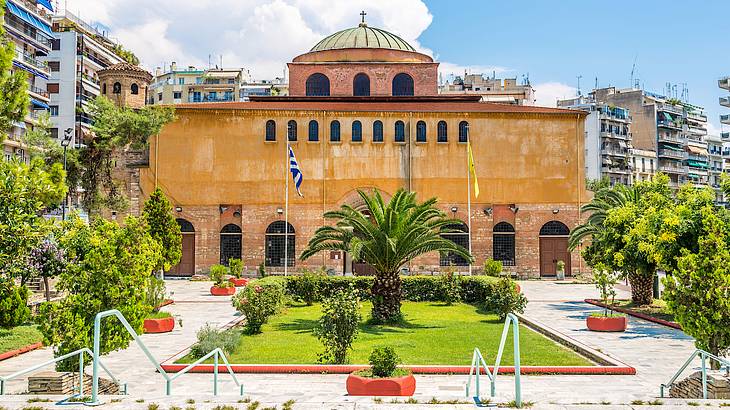
Cathedral Church of Hagia Sophia of Thessalonica, Thessaloniki
The Cathedral Church of Hagia Sophia of Thessalonica is one of the oldest cathedrals in the city and the world today. Because of its history and significance, it is has been included as a UNESCO World Heritage Site, and it is one of the most important landmarks in Greece.
The Cathedral was built in the 8th century A.D., and it was the largest church in the world until the Seville Cathedral in Spain was constructed. The church was dedicated to the second person in the trinity of God, Logos.

Monument of Alexander The Great, Thessaloniki
Alexander III of Macedon, popularly known as Alexander the Great, is one of history's greatest leaders (as the name implies). Alexander the Great was born in July 356 BC as the son of King Philip the 2nd of Macedon and died in June 323 BC.
He is considered a great leader because he used his power to establish the largest empire in ancient history during his time as ruler of Macedon and Persia.
The monument of Alexander the Great was done by the prominent sculptor Yiannis Pappas and is located in Nea Paralia, Thessaloniki just by the sea (also one of the best areas to live in Greece!). It was built to commemorate the achievements of Alexander the Great.
Finding the monument is not difficult as it is situated after the White Tower and the National Theatre of Northern Greece, the city's symbol.
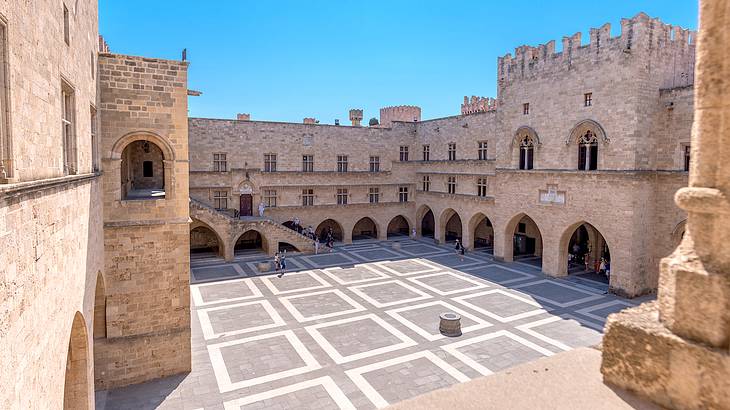
Palace of the Grand Master of the Knights, Rhodes
The Palace of the Grand Master of the Knights is located in the medieval city of Rhodes, which is a great place to visit in the summertime.
It has been used as a fortress, a Palace for the Grand Masters, and an administrative centre for the Knight Hospitaller. This same palace served as a holiday residence for the King of Italy in the 20th century.
At the main entrance, you will directly see the two towers that guard the entrance. Once you go through the entrance, you will enter a large courtyard. You will understand the reason why it is referred to as a grand palace from there.
☂️ Explore Palace of the Grand Master of the Knights of Rhodes on a tour
Lindos Acropolis, Rhodes
Lindos Acropolis sits high up on the cliff tops on the east coast of Rhodes island in Greece. The site has been built and added to by many, but the Dorians around 3000 years ago first settled it.
Today, the pillars and beautifully inscribed stonework tell of a richly decorated age. Climb over 100 feet to the top through the winding, somewhat precarious steps to the wonderful Acropolis, which overlooks the charming, traditionally Greek town of Lindos.
If you're visiting as part of a Rhodes family holiday, then beware of some sharp drops on the walk up. The views across the sea are spectacular, and it's really a great location.
The Acropolis itself is spread across a relatively large area and is surrounded by battlements built by the Knights of St John. Also, there is the Temple of Athena Lindia and the 20 columns of the Hellenistic Stoa.
While there aren't any facilities at the Acropolis, don't miss the opportunity to stop off for a bite to eat at the picturesque town of Lindos below. Many of the restaurants offer fantastic views up to the dramatic remains.
A word of caution, though, the walk up, while not a major hike, is still a fair trek, but don't be tempted to ride the donkeys waiting to carry visitors on their backs.
There's considerable evidence that they are not well looked after, and animal-rights groups are very vocal at asking people not to use them to get to the top.
☂️ Visit Lindos Acropolis on a tour
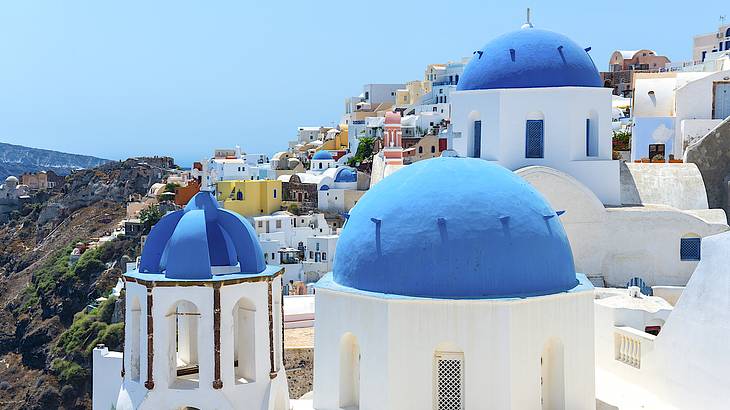
Domes of Santorini, Santorini
The domes of Santorini are some of the most famous landmarks in Greece. You might recognise them from photos that you have seen of Santorini.
They are blue and are beautiful in combination with the whitewashed Greek houses. Their beauty and photogeneity are what makes them unique. Also, they appear in a lot of the best photo spots in Santorini.
The domes are located in the town of Oia. The domes are the rooftops of two churches, the churches of Anasteseos and Agios Spiridonas. Because of the politics of wanting unity in how the country looks, many houses were painted white and blue in the past, as were these churches.
Standing near them, you have some of the island's best views over the town and the sea. Also, there are some shops and restaurants near that are lovely to visit.
From here, you can also see the sunset, which is beautiful to see in Oia! Several people go to Oia to get together and watch the sunset with live music.
To get to the blue domes from the main street, you have to go through a small alley. Many alleys look like they do not end up anywhere, but they do!
☂️ Join a tour to see Oia
- Santorini Luxury Caldera Cruise With Full Greek Meal & Sunset (usually sells out)
- Private Santorini Tailor-Made Choice of the Guest (rated highly)
Akrotiri, Santorini
Akrotiri is a bronze age settlement, and it's one of the most important Minoan urban centres in the Aegean Sea. It is particularly famous because it was completely swallowed in lava during the 1628 BC volcano eruption on Santorini.
Today, Akrotiri stands as one of the largest historical sights in the Greek Islands. The ancient site connected mainland Greece with Egypt and Syria's ports before being destroyed in the Theran Volcano eruption.
Akrotiri is also one of the best sights to visit in Santorini in winter and in summer. It is referred to as the 'Greek Pompeii' since many civilians were buried alive in the ashes and discovered centuries later.
When visiting, you can see frescoes created thousands of years ago when the masters were using mineral-based colours, and the dominating hues were brown, red, black, and blue.
The Greek historical sight is more of a complex with a large wooden roof that details each settlement. Some famous settlements or areas are the House of Anchor, Sector Gamma, and the House of Ladies.
The famous landmark is open every day. Many tours operate from more popular points on the island and come with a professional guide to lead you through the ruins.
☂️ Explore Akrotiri with a tour
- Best of Santorini Customized Private Tour (often praised)
Apollo Temple - Portara, Naxos
You can find many excellent places to stay in Naxos along with an array of top landmarks to visit. One of the most well-known landmarks is the Portara of Naxos stands high on a hill overlooking the sea and is the remains of a colossal marble doorway that was part of the Temple of Apollo. The temple lies close to the port, on the islet of Palatia.
There was once a strip of land that connected the islet with Naxos, but today, there is a causeway. It is said in mythology that Theseus, having slain the Minotaur in Crete, abandoned his lover, Ariadne, on the islet.
In 580 BC, Lygdamis, the ruler, wanted to build the largest and grandest temple in Greece on Portara - in honour of Apollo, the god of music and poetry. Work began on its construction with the doorway, which faces the island of Delos, the birthplace of Apollo.
War broke out between Naxos and Samos, and work on the temple stopped abruptly. Lygdamis was overthrown, and the temple was discarded, but its impressive doorway still stands today.
The columns are six meters high and weigh 20 tons each, and the entrance measures 3.5 meters. Interestingly, some historians believe the temple was dedicated to Dionysus, the god of wine, as he was the god of the island.
The Temple of Apollo/Portara is one of the best things to do in Naxos and is just a short walk from the port – albeit uphill! There are fantastic views of the harbor, the beautiful Aegean, and the islands of Delos, Mykonos, and Syros. Those in the know visit in the evening, as watching the sunset from here is spectacular.
Archeological Site of Philippi, Krinides
The Archeological Site of Philippi hosts the ruins of a major Greek city with significant importance to ancient Greece. Over the centuries, powerful Kings, Greeks and Romans, Christian missionaries, and many others have left their traces behind in the monuments lying graciously in the Philippi grounds.
Events that have taken place through the centuries in Philippi have shaped the Western world. The archaeological site is the most important archaeological site in the Eastern Macedonian territory of Greece.
Philippi was added to UNESCO's list of World Heritage Monuments in the later years. Its monuments, dating back to the Early Christian Era, are also among the world's best-preserved ones.
The ancient city of Philippi was a land colony of the Thassians, called Krinides, and was founded in 360 BC. The area was important for two reasons: the gold mines in the neighbouring section and the land's geographic position, which allowed the Krinides to establish military troops at a strategic passage.
Later in history, during the Roman Era, important battles were fought in Philippi. For a few centuries, the town was renamed Colonia Augusta Iulia Philippensis in honour of Caesar Augustus. The importance of the city continued from the Early Christian era to the Byzantine era.
Located only 11km away from Kavala town, which is a major Greek seaport, visiting the Philippi archaeological site can be paired with other day trips and activities. The site is also very close to the second biggest city in Greece, the capital of Northern Greece, Thessaloniki.
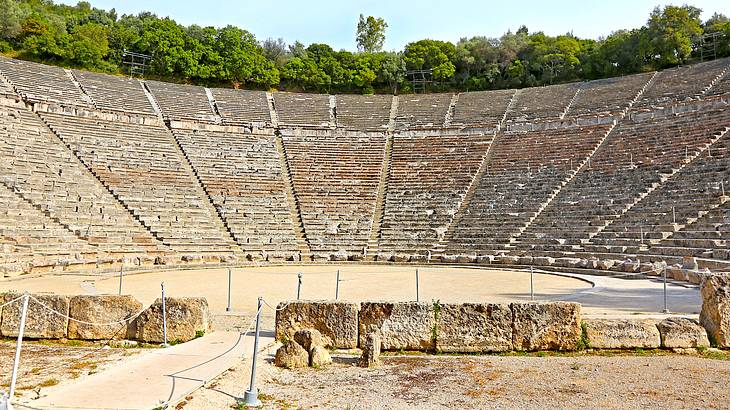
Ancient Theatre of the Asklepieion at Epidaurus, Epidavros
The Ancient Theatre of Epidaurus is one of the most famous ancient Greek landmarks. It is located in the city of Epidaurus in Greece.
The theatre was built by Polykleitos the Younger in the 4th century, and it is one of the most well-preserved monuments of its kind. One amazing thing is that the theatre is still in operation today, but mainly for the annual Epidaurus Festival.
The original seating capacity of the theatre was 8,000 people, but it was expanded in the 2nd century to hold more. This theatre has a unique design compared to other theatres in Greece. Most of the seating is still visible, so it is easy to imagine how the ancient Greeks used it.
☂️ Visit Ancient Theatre at the Asclepieion of Epidaurus with a tour
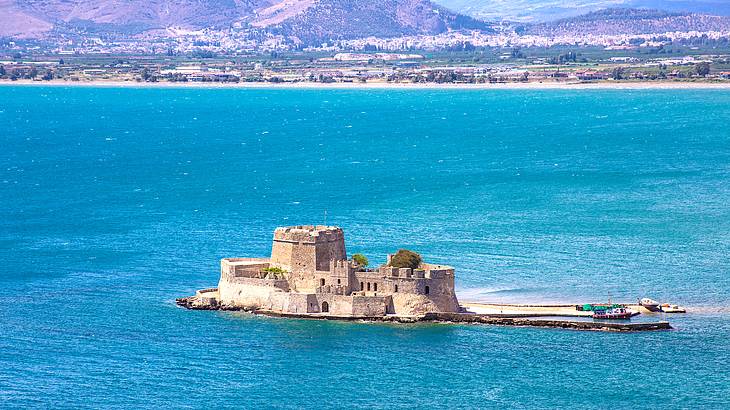
Bourtzi Castle, Nafplio
The Venetians constructed Bourtzi Castle, located in the Argolic gulf and near Nafplio, in 1471. Bourtzi was originally a defence castle for the city, with thick chains running from the Castle to the mainland to prevent enemy ships from docking onshore.
The Castle became the executioner's residence between 1865 and 1935 because no one wanted to associate with someone who did that for a living.
Today, the Castle sits empty, inviting curious visitors. Small boats carry tourists to the fortress as it is the only way to get close to the Castle, and it takes a lot less time. The view from the Castle is impressive, especially before sunset.
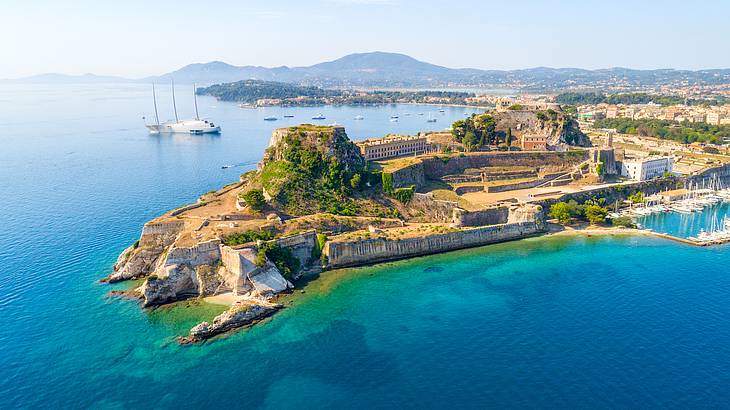
Ionian Islands
The Ionian Islands are located in the Adriatic Sea on the west coast of mainland Greece. One significant difference between the Ionian Islands and other islands in the region is the lush and green nature it has. The Ionian Islands comprises six major islands: Corfu, Zakynthos, Lefkada, Paxos, Kefalonia, and Ithaca.
The Ionian Islands are ideal for families and individuals during a summer or winter visit to Greece. Regardless of the season, the weather here is pleasant throughout the year. The mountains protect the islands from the cold northern winds during the winter and summer.
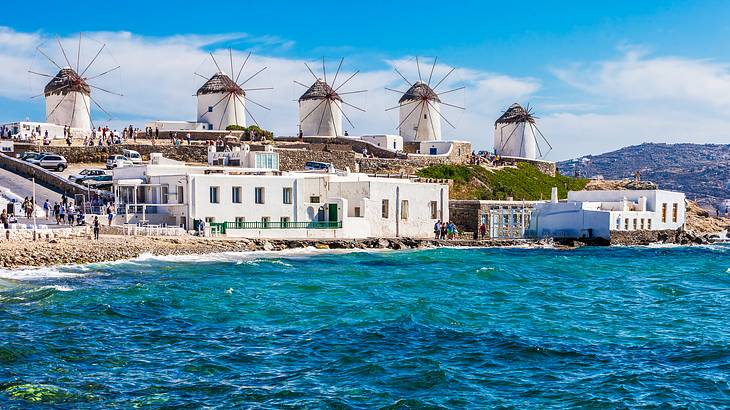
Mykonos Windmills, Mykonos
Mykonos is one of the must-see islands when you travel to Greece. It attracts scores of visitors from all over the world for many reasons—the main one being for relaxation and entertainment in a beautiful environment.
Mykonos is well known for being a popular destination for partyers. The island often hosts world-renowned DJs and artists at its world-class clubs and venues.
Besides the nightlife, Mykonos also has some interesting landmarks, one of them being the Mykonos Windmills. The Mykonos Windmills were used for practical reasons in the past, but today they are not in use.
The windmills were constructed in the 16th century and were used to mill wheat grown on the island. Now, the windmills are there, standing pretty for tourists to take pictures beside them. To be closest to this unique landmark, Mykonos Town is the best place to stay in Mykonos during your trip.
☂️ Explore Windmills of Mykonos with a tour
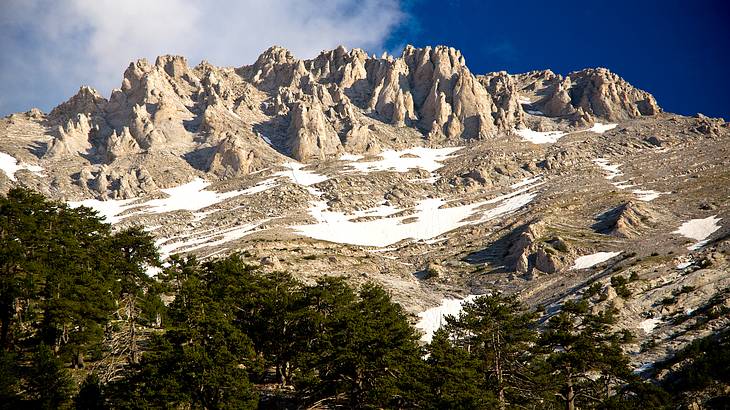
Mount Olympus, Olympus Range
Mount Olympus is one of the popular landmarks in Greece because it is the highest mountain in the country, with 52 peaks and gorges. It is believed that the mountain is the mythological home of the twelve gods of Olympus, and it is one of the most famous natural landmarks in Greece.
If you are interested in hiking while you are in Greece, Mount Olympus is a good option. While trekking up this mountain is not that difficult, an overnight trip might be needed, depending on which hike you choose.
Several trails take you through and around Mount Olympus. One of the easiest is from Prionia to Agios Dionysios Monastery. The trail starts at the Prionia parking lot, which is where you can take the E4 path. The hike is not a circuit, though, so you will not be returning along the same route that you started from.
The Prionia trail is quite lovely; you'll pass through canyons and streams and will have panoramic views of the mountain. All around, it is about 6 kilometres of walking and should take you no more than 2.5 hours.
If you are looking for a longer walk, several other trails leave from Prionia. You can also hike to another town, Litochoro, or Mount Olympus Refuge A.

Archaeological Site of Olympia, Olympia
Olympia is a famous ancient Greek site located in western Peloponnese. It was used to host the Olympic games, which were founded in the 8th century B.C.
The sites within Olympia include athlete training locations, temples dedicated to the Greek gods Zeus and Hera, and a stadium for sporting activities.
The Archaeological Site of Olympia is a UNESCO World Heritage Site. According to UNESCO, the site is one of the most relevant landmarks in the world as it shows visitors how the Olympic games began and why it is so important in the world of sports today.
☂️ Explore Archaeological Site of Olympia on a tour
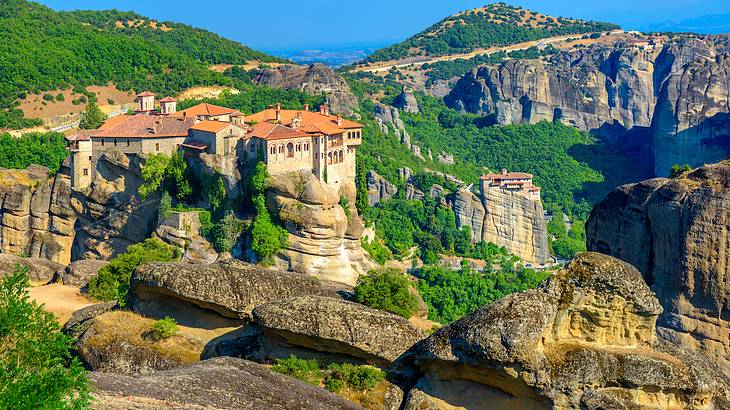
Monasteries of Meteora, Kalabaka
Meteora is a mind-blowing beautiful group of vertical rocks, reaching about 300 metres high. On these amazing rock formations, you will find the six monasteries of Meteora.
Each monastery appears as though it is hanging in the air. The monasteries were constructed in the 13th century with an initial number of 24 altogether. Today, Meteora has only six monasteries left.
If you want to enjoy the experience of visiting Meteora, the best way to explore it is on foot. Hiking from one monastery to another allows you to take in the scenery all around you.
If you are not up for walking, the monasteries are also reachable by car. However, be warned; they can be quite popular in the warmer months. If you are travelling by car, be sure to go as early as possible to avoid crowds.
Lots of tourists visit by car and on tour busses. Once the tour buses arrive, it can get quite overwhelming at the monasteries and on the narrow roads leading up to each monastery.
Take note that you will have to cover your shoulders and up to your knees to enter each monastery, and they all have their own different fee at the entrance. The six monasteries to explore are:
- Great Meteoron Monastery
- Varlaam Monastery
- Roussanou Monastery
- Agios Nikolaos Anapaphsas
- Agios Stefanos
- Holy Trinity Monastery (Agia Triada)
☂️ Visit Meteora with an excursion
- Meteora Day Trip From Athens by Bus With Optional Lunch (high demand)
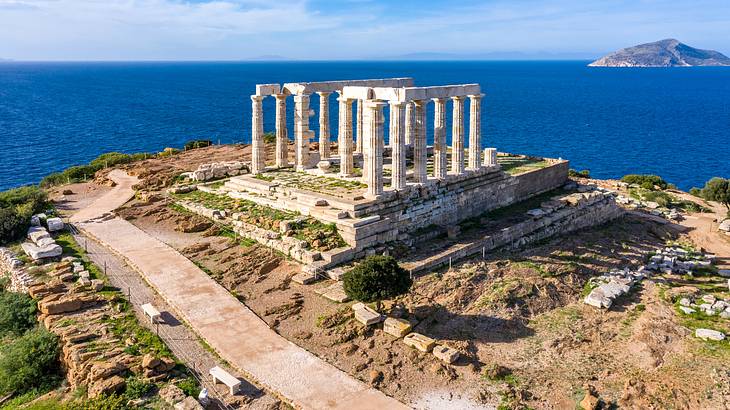
Temple of Poseidon, Cape Sounion
The Temple of Poseidon is located at the end of the Sounio Peninsula. The entire monument was built using marble in the 5th century BC to honour the Greek god of the sea, Poseidon.
For about three centuries, the monument was used as a sacred place for the Greek people. A grand festival was organised every four years, allowing some official to sail around it in a sacred ship. Why not consider sailing around Greece yourself? You're sure to have a grand time!
If you enjoy relaxing under the sun, the Temple of Poseidon is the best monument to visit when you are in Athens. It is an archaeological site enriched with ancient history situated along a beach; the perfect location to relax and educate yourself at the same time.
☂️ Explore the Temple of Poseidon on a tour

Archaeological Site of Mystras, Laconia
The Archaeological Site of Mystras is a UNESCO World Heritage Site and a top historical landmark in Greece. The fortified town was built in the mid-1200s and is located on the Taygetos Mountain, overlooking Sparta.
The site is divided into two sections: the Lower Town and the Upper Town, but one ticket can be used to enter both areas. You can enter via one of the two entrances, either at the bottom or at the top (where the fortress is).
When you climb up for 10 minutes at Upper Town, you will eventually reach the fort. Here, you will be treated with stunning 360-degree panoramas of the area.
As these medieval Byzantine ruins are situated on a mountainside, some level of fitness will be required to hike around the grounds. Make sure to keep cash on you and note that toilets are only available in the Lower Town.
In Summary
As you can see, Greece has many famous landmarks for you to visit. Almost every popular city in the country has a historical or ancient monument for you to explore. You just have to take your time to go through the options.
The list above is just a shortlist of some of the most famous landmarks of Greece to see. It is intended to help guide you with your trip planning for Greece.
It is not compulsory to visit all of the attractions mentioned to have a great time, but seeing them when you get a chance is something you must not overlook.
Give us feedback about this article
More visual stories related to this article:
Want to keep exploring?
Subscribe for discounts on tickets and hotels and our latest guides.
Thank you for subscribing
We will be in touch soon with discounts on tickets and hotels and our latest guides.
Want to keep exploring?
Subscribe for discounts on tickets and hotels and our latest guides.
Thank you for subscribing
We will be in touch soon with discounts on tickets and hotels and our latest guides.

